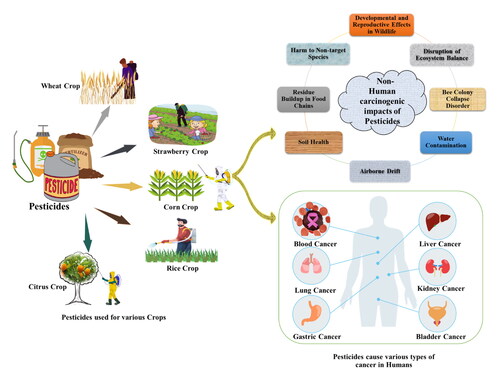Abstract
The fields of agronomy and pesticides have assumed significant roles in contemporary society. Pesticides can have adverse effects on human health, both in the short and long term. We have conducted a comprehensive analysis of the various categories of pesticides, providing a thorough examination of their modes of operation, prevalence, and global utilization. A critical review of reported research has been conducted to investigate the carcinogenic effects of agricultural pesticide use on human health. The widespread utilization of malathion and parathion for pest management indicates that individual occupational choices significantly impact their exposure to these chemicals. Pesticides can cause neurological abnormalities, reproductive problems, respiratory irritations, ecological disturbance, and the emergence of pest resistance, among other sublethal consequences beyond their carcinogenicity (breast cancer, lymphomas, multiple myeloma, bladder cancer, and leukemia). Ultimately, there is an anticipation for a forthcoming surge in endeavors to mitigate the utilization of hazardous pesticides and the consequent peril they pose to human well-being and the ecosystem.
REVIEWING EDITOR:
1. Introduction
Pesticides are chemicals or bio-chemicals that are used to protect crops against pathogens (microorganisms, i.e. bacteria, viruses, fungi, or other agents) and pests (insects, rodents, or unwanted plants, etc.). Their use has also expanded considerably during the previous decades (Mahmood et al., Citation2016). They have been crucial in improving farms and gardens, public health projects, enterprises, and urban green zones to serve humanity (Ignatieva et al., Citation2020). They are also used to improve the quality of gardens and sports fields, as well as to keep highways and trains safe. Pesticide use in Asia during 1990–2022 period remain 1.17 kg per ha per year (Mahmood et al., Citation2016). Pesticides are not just utilized in agricultural arrangements; they are also widely employed to prevent bug infestations around the world (Hossain et al., Citation2017). They are used to get rid of mosquitoes, cockroaches, fleas, rats, ticks, and other hazardous creatures in homes. Herbicides are used to reduce grasses and other unwanted vegetation (Sherwani et al., Citation2015). Although, insecticides are used to control a wide range of insects (Iqbal et al., Citation2021). Pathogen spread can be controlled by disinfectants, while rodents and rats can be eliminated with poisonous chemicals (Rani et al., Citation2021). Somehow, in different ways, its toxic side effects have negative impacts on environmental degradation (rivers, fauna, flora, and soil) in addition to negative consequences on human and animal health. As a result of innovations in product manufacturing, formulation, and administration, modern herbicides are safer than ever before. They are more effectively targeted and disintegrate faster in the environment than in the past (Fluegge, Citation2017; Mostafalou & Abdollahi, Citation2017; Nicolopoulou-Stamati et al., Citation2016).
1.1. Historical background study
People have been utilizing various compounds as insecticides since the time of the Ancient Romans. During that period, sulfur, sulfur salts, and bitter ashes were used as insecticides (Pathania et al., Citation2020). Arsenic was promoted as an insecticide by a Roman naturalist (Rather et al., Citation2022). Similarly, a mixture of honey and arsenic was used to control insects in the 1600s. In the late 1800s, farmers in the United States began using chemicals, such as nicotine sulfate, calcium arsenate, and sulfur for field-related objectives (Saranya et al., Citation2020), but their efforts were futile due to the poor methods of administration. In 1867, arsenic and impure forms of copper were used to control the Colorado potato beetle infestation in the United States (Saxena, Citation2021). In 1885, Professor Millardet developed a copper-based treatment for mildew by utilizing Paris Green (a form of copper arsenate) to control a Colorado potato fungal infestation (Bergamaschi et al., Citation2022).
Germany first manufactured potassium dinitro-2-cresylate in 1892 and made various advancements during and after World War II with the synthesis of numerous efficient and cheaper insecticides. Aldrin, Endrin, and Dieldrin were discovered in 1939, together with Benzene Hexachloride (BHC), Dichlorodiphenyltrichloroethane (DDT), Chlordane, and 2,4-Dichlorophenoxyacetic Acid (2,4-D) (Hassaan & El Nemr, Citation2020). During the Vietnam War, Monsanto developed an experimental battlefield pesticide named Agent Orange, which was widely used (Dixit et al., Citation2018). Yet, there was a dramatic decrease in the development of novel pesticides after 1962 as public awareness of the environmental hazards associated with reckless pesticide use increased. Furthermore, in 1962, American scientist Rachel Carson noted that DDT field sprinkling caused direct or secondary poisoning of non-target species, resulting in their mortality. Integrated pest management refers to the employment of a combination of biological, chemical, and cultural strategies as opposed to enterprises, such as fisheries, where researchers examined a new sustainable control of agricultural pests. Although IPM can considerably lower pest populations, particularly during pest outbreaks, it does not replace chemical pesticides (Hyder et al., Citation2021). In 1970s and 1980s, sulfonylureas, pyrethroids, and synthetic fungicides, such as metaxyl and triadimefron were used (Mahmood et al., 2015). In the United States, DDT was outlawed in 1972, followed by limits on the use of endosulfan, dieldrin, and lindane. The Stockholm Convention, approved by 179 countries in 2001, agreed to eliminate twelve persistent organic pollutants (POPs), including DDT, from the environment. The European Union (EU) is in favor of banning neonicotinoid pesticides (Valavanidis, Citation2018). Pesticide use in aquatic habitats has been linked to a significant risk to fish species, notably salmon. Pesticides have also been shown to affect primary producers and macroinvertebrates. The National Forensic Service Headquarters in Seoul, Korea, has reported 447 deaths due to pesticide poisoning, based on a five-year survey that took place between 2005 and 2009. This study demonstrated that one of the main issues with public health in Korea is pesticide poisoning mortality (Lee et al., Citation2010). The high frequency of neuroblastoma in infants and young children, the well-established link between it and parental pesticide exposure, and the estimated relative risk (RR) of around 2.3 (Mostafalou & Abdollahi, Citation2017). A bibliometric study of the research published between 2011 and 2020, based on 62 publications selected from the Scopus database, examined the relationship between the incidence of cancer and occupational exposure to pesticides. The most common cancers to be found were prostate cancer, breast cancer, bladder cancer, non-Hodgkin’s lymphoma, multiple myeloma, and leukemia (Pedroso et al., Citation2022).
1.2. Biological pest control
Biological pest management is the primary strategy at the moment that employs both biocontrol agents and other living species (Chen et al., Citation2022). These biocontrolling compounds are also known as biorational pesticides. Insect growth regulators (IGRs) are chemicals that inhibit insect growth and metamorphosis without affecting non-target organisms. IGRs include synthetic analogues of insect hormones as well as non-hormonal chemicals that suppress chitin production. This biological pest control is a sophisticated, bio-rational pesticide (Mahmood et al., 2015). DNA-based pesticides are a relatively new method of controlling insect pests. One of them is the concept of pesticides based on nucleic acids. They include anti-apoptotic short single-stranded DNA segment insecticides (Andiappan et al., Citation2018), nuclear polyhedrosis virus genes, and formulations based on lengthy double-stranded DNA segments. The rationale underlying the development and application of such preparations is analogous to approaches for silencing the expression of critical genes via RNA interference (RNAi) processes. The first real findings in this area demonstrate the promise of insecticidal nucleic acid formulations. Oberemok and Skorokhod (Citation2014) showed that by leveraging the insecticidal capabilities of viral DNA fragments, it is possible to create safe, low-cost, and fast-acting DNA insecticides to lower the population of gypsy moths. The Lymantria dispar multicapsid nuclear polyhedrosis virus (LdMNPV) is widely known for controlling gypsy moth populations in nature. Their findings demonstrated that insecticides based on the inhibitor of apoptosis (IAP3) gene cause gypsy moth mortality to be higher than in the control treatment. DNA fragments have also been found to exhibit selective activity and are not poisonous to tobacco plants, such as black cutworm and hornworm (Oberemok, Laikova, Gninenko, et al., Citation2015; Oberemok & Nyadar, Citation2016; Oberemok & Skorokhod, Citation2014). This discovery enables the scientists to propose DNA insecticides as a potentially promising strategy for controlling insects (Oberemok, Laikova, Zaitsev, et al., Citation2015).
2. General classification of pesticides
2.1. Biopesticides
Biopesticides are made from animals, plants, or microbes that can kill, harm, or repel insects. They are less toxic, biodegrade faster, and are more specific to the insect (Rawat et al., Citation2020). Biopesticide use is increasing because of increased environmental consciousness and global demand for organically grown food (Manna et al., Citation2021). Instead of completely eliminating a particular pest, biopesticides usually try to keep a pest population under control. Biopesticides are classified into three types based on the active component used: microbial, biochemical, and plant-incorporated protectants (Islam & Morshed, Citation2013).
Microbial pesticides; Microbial pesticides are pest management products composed of naturally occurring or genetically modified algae, fungi, bacteria, viruses, and protozoans (Ignatieva et al., Citation2020). They are particularly specific by producing a specific toxin for pests, causing disease, preventing other microorganisms from attacking them through competition, or a variety of other mechanisms.
Biochemical pesticides and traditional chemical pesticides have a very close link (Verma & Bhardwaj, Citation2015). It differs from traditional pesticides due to its non-toxic mechanism of action on target species and natural occurrence. Pests’ modes of action are often more particular, in addition to having a limited target range. Insect pheromones that interfere with reproduction and fragrant plant extracts are examples of biochemical insecticides (Parween & Jan, Citation2019). The Environmental Protection Agency has approved ∼390 biochemical insecticides for use in 2020 (Pathania et al., Citation2020). Semi-synthetic products, plant extracts and oils, and insect growth regulators are classified as biochemical pesticides. As a result, these compounds are classified into four types: kairomones, pheromones, allomones, and synomones (Rathore et al., Citation2015).
Plant Incorporated protectants (PIPs); Pesticides known as plant-incorporated protectants are those that plants directly biosynthesize from genetic material. These plant tissues have been genetically engineered to create pesticides. Both the plant and the genetic material implanted produce PIPs. Cry proteins were the first PIPs used to kill insects in genetically modified (GM) crops with Bacillus thuringiensis transgenes (Kumar et al., Citation2021). They are based on next-generation double-stranded ribonucleic acid (dsRNA) and have only recently been approved (Sodnikar et al., Citation2021). Like with typical synthetic pesticides, the application of cry protein or dsRNA PIPs results in their release into recipient ecosystems. PIPs advance the science needed to identify the future environmental fate of dsRNA PIPs (Parker & Sander, Citation2017). The EPA approved the first PIP, SmartStax Pro, in June 2017 to help US farmers control maize rootworm, a damaging crop pest that has developed resistance to many conventional pesticides. It was created using RNAi technology to target the western corn rootworm (Diabrotica virgifera) (Shaffer, Citation2020). The RNAi mechanism works at the messenger RNA level, adopting a sequence-dependent mechanism of action that separates it from standard agrochemicals in terms of potency and selectivity. Furthermore, agricultural protection can be achieved not only by using PIPs through plant transformation but also by using non-transformative tactics, such as spray-able RNA compositions as direct control agents, resistance factor repressors, or developmental disruptors. This is in addition to the use of PIPs in plant transformation (Zotti et al., Citation2018).
2.2. Systemic pesticides
Plants and animals can absorb systemic insecticides and transport them to untouched areas. They can penetrate the plant and reach untreated areas of the foliage, stalks, and roots (Wojciechowska et al., Citation2016). The traveling route is through the vascular system, killing target pests that feed on the plant, even if only a small portion of the region is used. To manage vermin like lice, warble grubs, and fleas, systemic insecticides are applied to circulate through animals (Gerry & Murillo, Citation2019). Some poisons can only migrate up or down the plant, whereas others can only move one way (Relyea, Citation2012). It will spread throughout the plant if applied to the root zone, but not if applied to the leaves. A few herbicides are also known to be regionally systemic, which means they only migrate a short distance within a plant following interaction. It will spread throughout the plant if supplied to the root rather than the leaves. Glyphosate and 2,4-dichlorophenoxyacetic acid were systemic insecticides (Kramer et al., Citation1983; Parween & Jan, Citation2019).
2.3. Contact pesticides
In contrast to systemic pesticides, contact pesticides remain outside the plant and enter the skin of the bugs (Yadav & Devi, Citation2017). Pesticides kill pests by invading their bodies through their epidermis and poisoning them from the inside out (Rashid et al., Citation2010). Because pesticides do not usually permeate plant tissues, they are not carried via the plant’s vascular system. Contact pesticides, such as paraquat and diquat dibromide are examples (Hou et al., Citation2016).
2.4. Stomach poisoning pesticide
Stomach poisoning to slaughter insects can reach the insect’s body through its mandible and digestive system (Yadav & Devi, Citation2017). Pests swallow gastrointestinal toxins while eating because they consume the pesticide that has been put on the plant’s leaves and other portions. The mouths and digestive tracts of insects provide extra entry points for stomach toxins, which are then absorbed. This is especially true for vector control, in which deadly bacteria are mixed into water and consumed by mosquito or black fly larvae that feed on filters. Insecticides also kill the vector by destroying the larvae’s stomach (Yadav & Devi, Citation2017). Compounds, such as fluorides and arsenates, as well as malathion, are examples (Caldas, Citation2016).
2.5. Fumigants
Fumigants are pesticides that use vapor to kill target pests (Yadav & Devi, Citation2017). When applied to the target organism, it can produce toxic fumes. Pesticides in the form of vapor enter pests bodies via their spiracles and kill them by intoxicated their respiratory system (trachea) (Abubakar et al., Citation2020). Fumigants are used to kill pests in preserved fruits and vegetables (Pandya, Citation2018). It was also explored whether glucosinolate end products are volatile and may be used as insect fumigants. Insecticidal activity of these compounds as fumigants, as well as carbon dioxide production by insects, as a probe into their method of action. However, due to their insecticidal nature, the mechanism of action of these natural compounds is unknown (Tsao et al., Citation2002).
2.6. Repellent
For many years, repellent insecticides have been the most extensively utilized insecticides for insect killing. While the use of non-repellent compounds has been less popular, they can be effective tools in the fight against ants. As ants can rapidly identify chemical repellents, they will quickly learn to avoid them. If the ant colony is located indoors, repellent treatments may keep the ants inside, compounding the problem. Ibrahim et al. (Citation2001) identified the repellent properties of monoterpenes for the management of insect pests and infections, as well as the impacts of limonene on various bio-organisms (Ibrahim et al., Citation2001). The attractive effect of limonene on natural insect adversaries may lead to novel applications for natural chemicals (Mursiti et al., Citation2019). Plants treated with limonene, on the other hand, attracted phytophagous insects under particular conditions. Limonene is also phytotoxic to cultivated plants (Ibáñez et al., Citation2020; Isman & Miresmailli, Citation2011). Although the most common ways in which pesticides are used to work are shown in .
Figure 1. Modes commonly employed by pesticides to work (Abubakar et al., Citation2020).
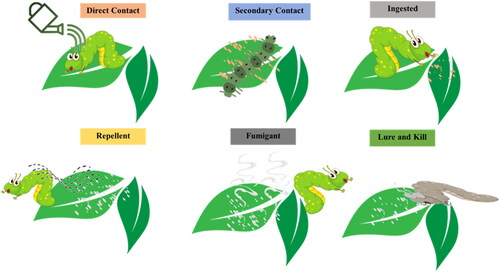
3. Classification on origin based
Pesticides are classified into several groups based on their origin. depicts some popular methods of identifying pesticides based on their source.
Figure 2. General classification of pesticides (Hassaan & El Nemr, Citation2020).
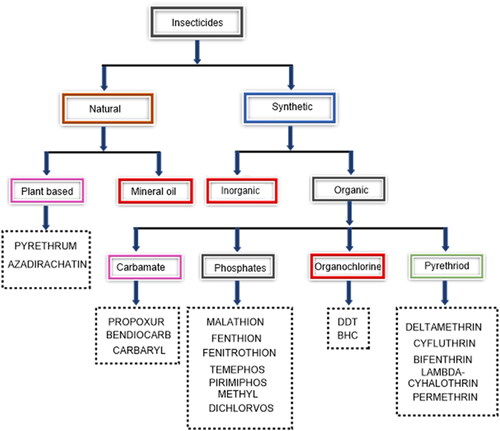
3.1. Natural pesticides
Natural pesticides are produced from natural sources, such as plants, minerals, and microorganisms that are used in agriculture to control pests and diseases (Khursheed et al., Citation2022). When compared to synthetic pesticides, these insecticides are typically thought to be less damaging to humans and the environment. Neem oil is a natural insecticide that kills a variety of pests, including aphids, mites, and whiteflies (Chiasson et al., Citation2004). Pyrethrin is a natural pesticide generated from the blooms of chrysanthemums. It is efficient against a variety of pests, including mosquitoes, flies, and fleas (Diaz, Citation2016). Bacillus thuringiensis (Kabtni et al., Citation2020) is a soil bacterium that produces a protein that is harmful to certain insects. It is widely used to get rid of pests like caterpillars and mosquitoes (Sanahuja et al., Citation2011). Diatomaceous earth is a powder formed from fossilized diatom remnants. It is a natural insecticide that is effective against a variety of pests, including ants, bed bugs, and fleas (Sarwar, Citation2016). Garlic oil is a natural insecticide that repels a variety of pests, such as aphids, mites, and whiteflies (Mfarrej & Rara, Citation2019). Furthermore, while natural pesticides are typically thought to be safer than synthetic pesticides, they can still be dangerous if not utilized correctly (Biondi et al., Citation2012).
3.2. Synthetic pesticides
Inorganic pesticides are composed of minerals or derived from other naturally occurring substances and are typically not derived from living organisms (Abubakar et al., Citation2020). Sulfur, copper sulfate, arsenic, and lead arsenate are examples of inorganic insecticides (Hassan, Citation2019). These chemicals have been used in agriculture for decades to control pests and protect crops. Inorganic insecticides in nanoformulation are numerous nano-sized inorganic substances that have pesticidal activity (Shah et al., Citation2016). Metals like copper (Cu) and silver (Ag) are used in the formulation of these inorganic nanopesticides, as are metal oxides, such as silica, titanium oxide, zinc oxide, alumina, and nanotubes (Saleem & Zaidi, Citation2020). Silver is the most well-investigated of these metals due to its potent antiviral, antifungal, and antibacterial properties (Ali et al., Citation2021).
Organic pesticides are derived from natural sources (Cantrell et al., Citation2012) and manufactured from natural ingredients, such as plant extracts, minerals, and microbes (Cavoski et al., Citation2011). Organic insecticides are also thought to be less damaging to the environment and human health (Mie et al., Citation2017). They degrade faster in the environment and have lower toxicity than synthetic insecticides. Neem oil, pyrethrin, and copper sulfate are examples of organic insecticides (Moorthy, Citation2018). The USDA National Organic Program and other organizations have certified these insecticides as suitable for use in organic farming. Most insecticides now are organic compounds, which include both natural insecticides (Yadav & Devi, Citation2017), such as safrole (1), estragole (2), benzyl acetate (3), pyrethrum (4), azadirachtin (5), and sesamol (6) and synthetic insecticides (7–22), as shown in and .
Figure 3. Chemical structures of natural organic pesticides (Yadav & Devi, Citation2017).
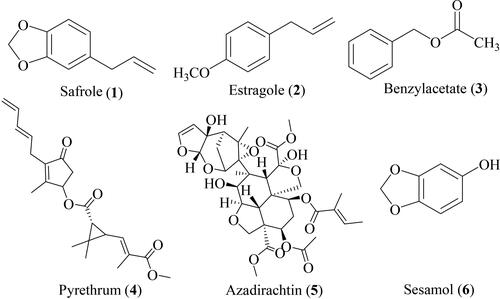
Figure 4. Structures of various synthetic organic pesticides (Yadav & Devi, Citation2017).
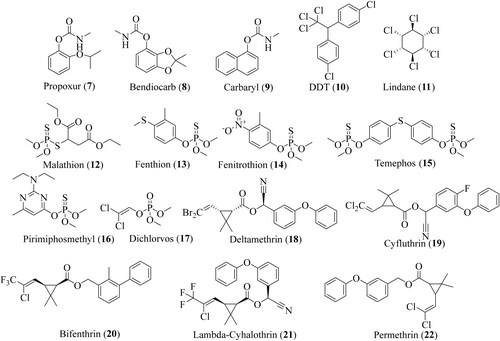
4. Mechanism of action
Pesticides are also categorized according to their mode of action, which describes how they kill or control the pests. Acetylcholinesterase inhibitors, which disrupt nerve function in insects; mitochondrial electron transport inhibitors, which disrupt energy production in cells; and growth regulators, which impede insect development, are examples of modes of action. Pesticides function by attracting, enticing, and then killing or repelling bugs. In agriculture, nanoparticles with a silica content are employed to control insects (El-Naggar et al., Citation2020). In fact, they are absorbed and transported into the lipids of the cuticular layer of insects, which are damaged and cause the insects to die (Saw et al., Citation2023). Pesticides are also acted on worms and pests to kill them, and their mode of action is depicted in .
Figure 5. Mode of action of pesticides (Rajamani & Negi, Citation2021).
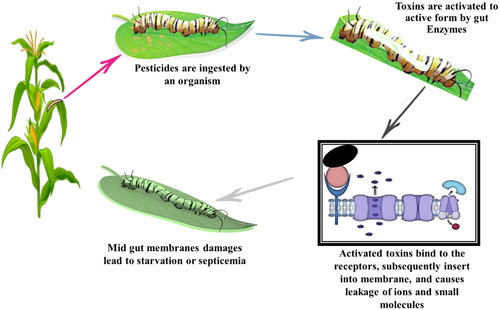
The enterotoxicity of silica nanoparticles (SNPs) against the rice weevil Sitophilus oryzae, as well as the fact that amorphous SNPs are extremely effective against this insect (Debnath et al., Citation2011). Many fungicides (23–30) have been discovered (), but their mode of action is uncertain. Although, Oxathiapiprolin’s intracellular target is oxysterol binding protein (OSBP), which is a lipid transfer protein involved in lipid metabolism, signal transduction, and intracellular sterol transport. Oxathiapiprolin’s interferes with a variety of oomycete cell functions, including maintenance of the cell membrane and lipid synthesis (Wang et al., Citation2023). Strobilurins are more effective against those living bodies that employ mitochondrial respiration, broken down more quickly in fungi and yeasts exhibit increased sensitivity; at large dosages, toxicity even develops in these cells. Due to the lack of mitochondria in bacteria and viruses, strobilurins have no direct impact on them (Lee & Kim, Citation2022).
Figure 6. Chemical structures of various fungicides with unknown or novel mode of actions (Hagiwara et al., Citation2019; Heo et al., Citation2023; Hillebrand et al., Citation2019; Ito et al., Citation2023; Kimura et al., Citation2017; Ogawa et al., Citation2023; Salas et al., Citation2019).
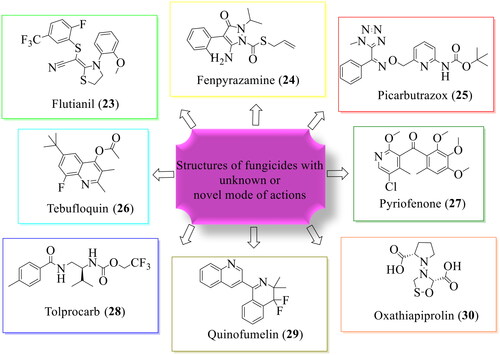
5. Fate of pesticides
The fate of pesticides after they are applied to plants is determined by several mechanisms. Initially, pesticides stick on the leaves, stems, and fruits of the plants that have been sprayed. Because they are absorbed by the plant, systemic insecticides have the ability to move throughout the vascular system and affect different regions of the plant (Lushchak et al., Citation2018). Certain pesticides go through metabolic changes inside plants, which are made possible by plant enzymes. This process might potentially reduce the toxicity of the pesticides by detoxifying them. Pesticides that have a high vapour pressure have the ability to volatilize into the air, which might cause movement off target and perhaps affect plants that are not intended targets (Bish et al., Citation2021). Pesticide molecules are broken down by photodegradation, which is triggered by exposure to sunshine.
Pesticides that are soluble in water have the potential to seep into the soil and pollute groundwater. Surface runoff can contribute to water contamination by bringing pesticides to surrounding bodies of water, particularly after rains (Reichenberger et al., Citation2007). Pesticides differ in how long they last; some degrade fast, while others pose a risk of buildup. Pesticide usage may also have ecological effects on non-target creatures in the environment, such as beneficial insects and aquatic life. Comprehending these mechanisms is crucial to reducing ecological footprints and promoting environmentally sound farming methods. Pesticides are taken up by plants as a source of surface run-off, volatilized, leaked out, and caused by the degradation of microorganisms ().
Figure 7. A complete fate of pesticides (Sarmah et al., Citation2004).
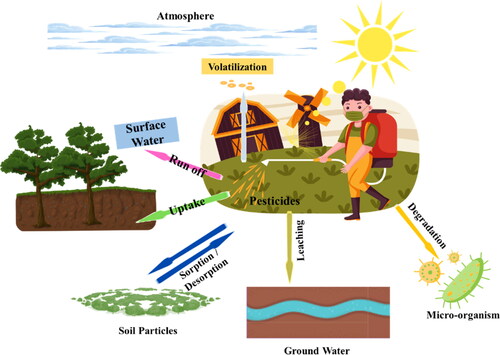
6. Pesticides and public health
There are numerous pheromones and other semiochemicals used to detect the presence of insects. They have been discovered as biopesticides and are used to protect plants and animals from pests (Blassioli-Moraes et al., Citation2019). A total of 10 million baits are grown each year for bulk capture and tracking, covering at least 10 million hectares (Witzgall et al., Citation2010). Air penetration and attract-and-kill tactics are utilized to regulate bug numbers on at least 1 million hectares. These are low-cost strategies because a small number of pheromones can attract and kill a large number of insects (Shorey, Citation1973). They are highly species-specific and do not cause harm to unexpected species. Pheromonal devices can gather a large number of insects from a distance for annihilation or eradication, saving time and effort (Yalçın, Citation2023). It is a straightforward way of tracking the growth of insect groups (Čokl & Millar, Citation2009).
According to one report, developing countries are aiming to expand their economies by utilizing non-potent, outdated, more toxic, and environmentally persistent pesticides to protect plantations and boost agricultural yields (Abdou, Citation2019). From 2006 to 2015, the national epidemiological profile of pesticide toxicity was evaluated, and 11,087 pesticide poisoning cases were registered. Throughout a 10-year period, there was an increase in pesticide poisoning events. Pesticide poisoning is a common public health hazard in Malaysia, with 3.8 incidences per 100,000 people (Bachmann, Citation2018; Kamaruzaman et al., Citation2020). Similarly, aluminum phosphide poisoning killed people in India (Parmar et al., Citation2015), whereas organophosphorus insecticide poisoning killed people (Eddleston et al., Citation2005). The medical records of 4148 pesticide-poisoned patients in Nepal were studied from April 2017 to February 2020, demonstrating that self-poisoning was the most common type of poisoning (95.8%) (Ghimire et al., Citation2022). After using Cupper-based fungicides for an extended period of time, it was found that coffee-growing soils in northern Tanzania had collected significant amounts of Cu in certain soils, up to 2670 mg kg−1 (Semu et al., Citation2019). A thorough meta-analysis utilizing peer-reviewed literature on agricultural insecticide concentrations in European surface waters was done. Consequently, 44.7% of the 1566 instances of measured pesticide concentrations (Pimentel & Greiner, Citation1997) in surface waters across the European Union (EU) were found to be higher than their corresponding regulatory acceptable concentration (RACs) (Stehle & Schulz, Citation2015). The Gomti River (India) water samples had an overall value of 519.9 μg L−1 of organochlorine pesticides (OCPs), although, the quantities in the sediments were determined to be 2572.5 ng g⁻1. Higher quantities of ƩOCPs in water samples are discovered, above the national standard limit (Sarker et al., Citation2021). More pesticides are used in Brazil than in any other Latin American nation. In actuality, Brazil’s usage of pesticides has surged by over 176% in the previous ten years, making it four times greater than the global average (Niemeyer et al., Citation2017).
Aluminum phosphide, organophosphorus (OP), phosphine gas, organochlorine insecticides (Mehrpour et al., Citation2012), and dichlorvos (Rao et al., Citation2017) were the most commonly found lethal pesticides that cause mortality. By enhancing the medical record system and collaborating with forensic toxicology laboratories, problematic HHPs can be identified (Ghimire et al., Citation2022). Based on these facts, it has been established that intentional pesticide consumption as a form of suicide has become an alarming trend among people. Pesticide poisoning remains a severe issue that must be addressed in order for additional regulatory steps to be taken to limit the number of individuals murdered by pesticide poisoning (Wesseling et al., Citation2005). To maintain controlled and limited access to these chemicals, the public must enforce pesticide regulation (Pelaez et al., Citation2013). More particular information on the chemicals involved in fatal poisoning improve regulatory decision-making (Syberg & Hansen, Citation2016). A small, controlled cross-over study found that asthmatics who were exposed to low pesticide droplets had worse asthma. After standard commercial pesticide exposure, 29% of individuals reported a 15% or greater decline in FEV1. The airway responsiveness was worse, while chest, nose, and eye symptoms were worse than with water (Amaral, Citation2014). Pesticide exposure is hazardous to both mild and severe asthmatics since the effects are comparable (Hoppin et al., Citation2008).
Famine is claimed to have killed many people as a result of the Green Revolution in the 1950s and 1960s (Pielke & Linnér, Citation2019). Unfortunately, it also transported very dangerous pesticides, such as parathion and endrin into impoverished rural communities that lacked the infrastructure needed to safely store and handle them. Pesticide self-poisoning quickly became one of the two most popular methods of suicide on a global scale (Liu et al., Citation2021). Despite the fact that no attempt has been made to count the overall number of deaths, since the Green Revolution, pesticide self-poisoning, a major public health and clinical issue in rural Asia for decades, should be a global public health priority (Karunarathne et al., Citation2020). In addition, Mew et al. (Citation2017) examined data from 108 nations from 2006 to 2015 and found that there has been a significant decrease in fatal pesticide self-poisoning in recent years, owing primarily to a decrease in China’s general suicide rate (Mew et al., Citation2017). Pesticide self-poisoning continues to kill at least one in every seven people worldwide (Mew et al., Citation2017). A Markov model was developed to analyse the costs and health implications of a national ban on toxic herbicides to reduce pesticide-self-poisoning deaths. The prohibition of highly toxic herbicides in 14 countries could reduce pesticide-related suicides (Lee et al., Citation2021). In a recent study conducted by researchers to assess the case death rate of agricultural pesticides in a prospective cohort in nine hospitals in Sri Lanka that were assisting rural residents and discovered a decrease in mortalities with non-banned pesticides (Buckley et al., Citation2021).
7. Consumption worldwide
To secure food security for the world’s rising population, all efforts must be made to boost agricultural output (Zhang et al., Citation2007). Reduce crop loss due to pest damage is one of the most critical jobs in ensuring agricultural output (Peshin et al., Citation2009; Peshin & Zhang, Citation2014). It is noteworthy to emphasize that crops are harmed by around 9000 species of insects and mites, 50,000 kinds of plant diseases, and 8000 species of weeds worldwide (Zhang et al., Citation2011). Insect pests were responsible for an estimated 14% of the loss, plant diseases for 13%, and weeds for 13% (Pimentel, Citation2009). Pesticides are thought to protect roughly one-third of agricultural crops (Liu et al., Citation2002; Wang et al., Citation2011). It was noticed that without pesticides, losses from insect injury to fruits, vegetables, and cereals might reach 78, 54, and 32%, respectively (Cai, Citation2008). While, when insecticides were employed, crop loss from pest injury decreased by 35–42% (Pimentel & Greiner, Citation1997). In the United States, fungicides were utilized in 80% of fruit and vegetable crops. The use of fungicides was expected to improve the economic worth of the apple by 1223 million US dollars (Zhang et al., Citation2011). Without pesticides, cotton, wheat, and soybean exports from the United States would fall by 27% (Zhang et al., Citation2011). A government survey found that Chinese farmers used three times more pesticides than the global average (120 kg/hectare) (Ma & Zheng, Citation2022). Greenpeace estimates that 70% of pesticides used in China are not absorbed by plants but instead leach into the soil and groundwater (Fan, Citation2017). Pesticide poisoning from insecticides, rodenticides, and herbicides accounted for 7.16, 6.47, and 3.42% of all the pesticidal poisonings, respectively (Chen et al., Citation2004; Zhang et al., Citation2011). The most common cause of human poisoning was high toxic organophosphate pesticides, accounting for 86.02% of all cases (Zhang et al., Citation2011). According to a study released in June 2017, about 3000 children in eastern China’s Zhejiang Province were poisoned by pesticides between 2006 and 2015, with the bulk of instances occurring during the agricultural season (Fan, Citation2017). In recent years, researchers have noticed that pesticide usage is connected to biodiversity loss throughout the world (Kumar et al., Citation2013; Zhang et al., Citation2011). There are around 20,000 bee species on the planet, and they pollinate more than 90% of the world’s 107 major crops. In contrast, bee populations have been progressively dropping in recent years. According to sources, 75% of the world’s honey contains traces of bee-harming pesticides, particularly neonicotinoids, including acetamiprid, clothianidin, imidacloprid, thiacloprid, and thiamethoxam (Sheridan, Citation2017). Neonicotinoids have been implicated in the global decline of bee populations. Scientists from Radboud University Nijmegen and the Entomological Society Krefeld have been studying insect species and abundance in over 100 Western European nature reserves since the 1980s, and they determined that the insect population in Orbroicher Bruch has decreased by 78%. According to a pitfall record (Zhang, Citation2018a), there were 143 species of hoverflies in 1989 and just 104 species in 2014. Pesticidal usage has also been related to several human and animal diseases, as well as lower fertility and IQ quotients in humans (Chen et al., Citation2004; Zhang, Citation2018a, Citation2018b; Zhang et al., Citation2011). Pesticides are widely employed in modern agriculture, and they are an efficient and cost-effective method of improving product quality and quantity, hence maintaining food security for the world’s growing population. Pesticides are used in around 2 million metric tons per year worldwide, with China contributing the most, followed by the United States and Argentina (Sharma et al., Citation2019). Although pesticides are useful in agriculture, their widespread usage can have serious consequences due to biomagnification and long-term environmental damage (Sharma et al., Citation2019). The global consumption of pesticides world-wide is reported in (Malyan et al., Citation2019).
Figure 8. Global consumption of pesticides (kg ha⁻1) (Malyan et al., Citation2019).
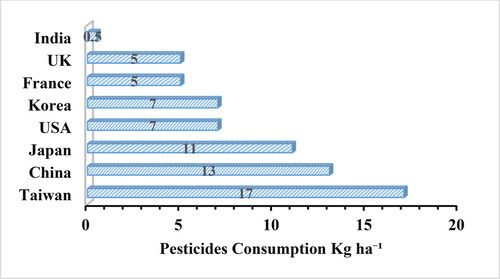
On a global basis, total pesticide use in agriculture remained stable in 2019 at 4.2 million metric tons (Mt) of active chemicals. Pesticides were administered to crops at a rate of 2.7 kg per hectare worldwide. Pesticide commerce totalled ∼5.6 metric tons of formulated goods in 2019, valued at USD 35.5 billion (Naeem et al., Citation2022). Despite a recent halt, total pesticide use increased by more than 50% between the 1990s and the 2010s, with pesticide use per hectare increasing from 1.8 to 2.7 kg/ha, while it has increased globally in terms of fungicides, herbicides, bactericides, and insecticides. Pesticides (40–53%), fungicides (25–22%), and insecticides (23–17%) are all being used more often. Pesticide commerce approximated 5.6 metric tons of formulated goods in 2019, valued at USD 35.5 billion. Total pesticide trade volumes tripled between the 1990s and 2010. Herbicides, fungicides, bactericides, insecticides, and plant growth regulators are the most often used pesticides, with 25.10, 12.06, 7.50, and 1.24%, respectively (Asiamah et al., Citation2020). Organophosphates are the most widely used insecticides worldwide, followed by carbamates and pyrethroids (Bhatt et al., Citation2021). Pesticides of various types have been introduced around the world in the last century, and many companies producing them are located in Europe and the United States. In the twenty-first century, the bulk of these firms merged. As the wave of pesticide technology reached Japan in the late 20th and early 21st centuries, Japanese-origin insecticides were produced one after the other. Japan presently has the best capability for pesticide production in the world (Pettis et al., Citation2005).
8. Carcinogenic pesticides
Several pesticides, such as organochlorines and sulfate, have been reported via animal models to cause cancer, while others, most notably chlordane, lindane, and organochlorine DDT, are sources of tumors. Certain chemicals used in commercial pesticide formulations can cause cancer. The International Agency for Research on Cancer has classified arsenic-based chemicals as carcinogenic, while pesticides for professional use have been identified as dangerous to people. Epidemiologic investigations found that phenoxy acid herbicides produced malignant lymphoma and soft tissue sarcoma (STS) (Jayakody et al., Citation2015); organochlorine pesticides caused non-lymphoma, Hodgkin’s disease and leukemia (Erba et al., Citation2019). Organophosphorus chemicals have also been linked to leukemia and NHL, while triazine herbicides have been linked to ovarian cancer (Miligi et al., Citation2006). Pyrethroids have an impact on molecules by attaching themselves to DNA and causing DNA methylation and other epigenetic changes. Additionally, they alter gene expression and interfere with the ER and AR receptors, which may lead to the production of quinones and semiquinones that might interfere with DNA topoisomerase II and damage DNA. Additionally, pyrethroids have the ability to produce reactive oxygen species (ROS), change cell adhesion, influence proliferation, and maybe disrupt AR and ER. Apoptosis can also be brought on by them by increasing DNA damage, as shown in (del Pilar Navarrete-Meneses & Pérez-Vera, Citation2019).
Figure 9. Impact of pyrethroid on hematopoietic stem cell (del Pilar Navarrete-Meneses & Pérez-Vera, Citation2019).
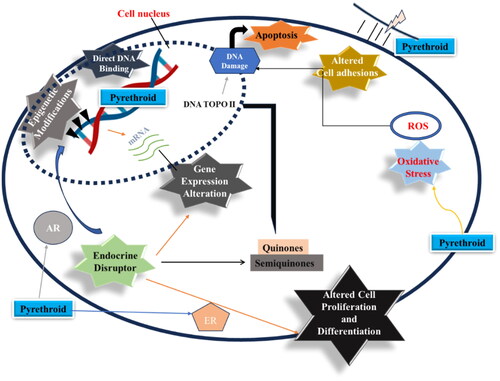
Despite the fact that organophosphorus has been linked to an increased risk of cancer, particularly hormone-mediated cancer, few prospective studies have looked into the use of specific insecticides. According to the findings, estrogen and OPs trigger a cascade of events that indicate a change in human breast epithelial cells. In vitro studies using an immortalized, non-tumorigenic human breast epithelial cell line may provide a technique to examine cell transformation under the effects of OPs in the presence of estrogen. The data suggested that these pesticides may have an effect on women’s cancer risk via hormones. It may be inferred that the process by which pesticides and estrogen change healthy breast cells into malignant ones (Calaf, Citation2021). Such chemicals cause genomic instability, which leads to tumor formation in animals as well as in vitro carcinogenesis indicators. Increased genomic instability has been associated with the inactivation of tumor suppressor genes and the activation of oncogenes in the presence of malathion, parathion, and estrogen (Calaf et al., Citation2021). Pesticide exposure leads to breast cancer (). Mammary gland tumors in female rats were created after exposure to parathion, acetylcholinesterase inhibitors, estrogen, and eserine to examine the mechanisms of carcinogenicity.
Figure 10. Pesticide exposure causes breast cancer (L’Héritier et al., Citation2014).
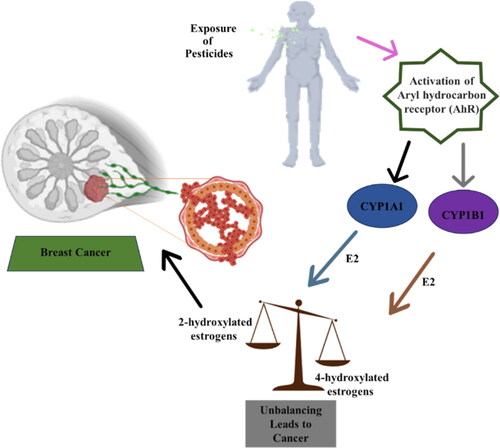
These insecticides and eserine inhibited blood acetylcholinesterase activity three to five times as much as atropine (Calaf, Citation2021). Furthermore, acetylcholine and similar compounds have been shown to be carcinogenic in vitro via cell metabolism, cell proliferation, expression of certain receptors (M2R, ER, ErbB2), and genomic instability (M2R, c-myc, mp53, ER). Pesticides boosted protein production via oestrogen but decreased it via atropine, according to genomic instability (Calaf, Citation2021). Insecticides, herbicides, and fungicides were the main pesticide classes studied in terms of their role in poisoning and cancer. Breast cancer, non-lymphoma, Hodgkin’s disease, prostate cancer, multiple myeloma, bladder cancer, leukemia, and multiple myeloma were the most commonly reported cancers (Goobie et al., Citation2015). Pesticides dilated ducts, which resulted in ductal cancer, whereas 17-estradiol resulted in lobular carcinomas (Nair & Sujatha, Citation2012). Both chemicals, as well as eserine or oestrogen, generate cancers in both structures (mammary duct and lung tumors), which then move to the kidneys after 240 days and other sources of lungs cancer are also listed in . Despite the well-established association between pesticides and cancer, research on the subject is still quite restricted in comparison to the extent to which these xenobiotic substances are utilized globally, which is related to the expanding global demand for agricultural products (Alavanja & Bonner, Citation2012).
Figure 11. Pesticides are a source of lung cancer (Bonner et al., Citation2017).
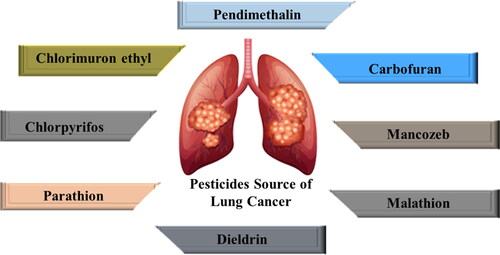
9. Safer pesticides
The use of the most cost-effective and environmentally friendly insecticides should be promoted. There is a need for handmade biopesticides that have enhanced food safety, increased work safety, and reduced concerns about insect resistance for the sake of humans and ecosystems (Islam & Morshed, Citation2013). Biopesticides are considered superior alternatives to chemical pesticides in pest management since B. thuringiensis (Kabtni et al., Citation2020) has a market share of nearly 95%. Bt formulations containing spores and crystals are used to control insect pests in a variety of agricultural and ornamental crops. Given that it is more efficient at high temperatures and lasts longer, it is a particularly promising biopesticide for climate change. Because conventional Bt biopesticides have drawbacks, novel techniques are being developed to improve their efficacy. In this new era, Bt and nanoscience in crop defense are untapped. To boost the potency of Bt, nanotechnology can reduce particle size and transport Crystal (Cry) toxin (Vimala Devi et al., Citation2019).
The development of nano-based smart pesticides that adhere to environmentally safe standards has reduced the requirement for conventional pesticides. Nano-encapsulated insecticides with controlled release kinetics can significantly increase permeability, stability, and solubility. Nanoencapsulation can improve pest control efficiency over longer periods of time by preventing active substances (Nuruzzaman et al., Citation2016) from degrading prematurely in poor environmental conditions. Chemical pesticides have a high number of varieties, i.e. around 105, that have recently been launched or are presently being developed, including fungicides (43), insecticides and acaricides (34), nematicides (6), herbicides (21), and herbicide safeners (1) (Umetsu & Shirai, Citation2020). The vast majority of them are both environmentally benign and human-safe. Succinate dehydrogenase inhibitors, quinone outside inhibitors, quinone inside inhibitors, and demethylation inhibitors are the most sophisticated fungicides. As a result of the rise of resistance to fungicides with established modes of action, many fungicides with different, unique modes of action have been released or are currently being developed. The development of insecticides is shifting away from synthetic pyrethroids, carbamates, and organophosphorus pesticides toward nicotinic and diamide pesticides (Sparks & Bryant, Citation2022). Over the last ten years, compounds with a variety of novel modes of action have been presented or explored. Despite their low toxicity to bees, flupyradifurone and flupyrimine have been produced and utilized in crops (Jeschke, Citation2021). Several herbicides with varied modes of action, including those that block p-hydroxyphenylpyruvate dioxygenase, acetolactate synthase, exceptionally long-chain fatty acid elongase, and protoporphyrinogen oxidase have been studied (Dayan et al., Citation2015). Both recently introduced drug cyclopyrimorate and the investigational drug tetflupyrolimet have unique mechanisms of action, specifically against the inhibition of homogentisate solanesyltransferase and dihydroorotate dehydrogenase, respectively (Golubev, Citation2022). Moreover, nematicides and beneficial acaricides are being created. show the chemical structures (31–65) of general fungicides (Qoi, Qil, DMI, and SDHI).
Figure 12. General chemical structures of various fungicides (Campagnac et al., Citation2009; Gu et al., Citation2021; Hatamoto et al., Citation2021; Yao & Mathieson, Citation2023).
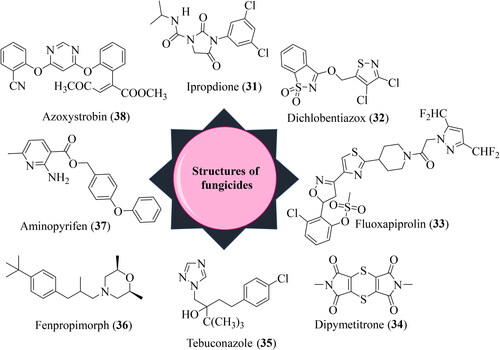
Figure 13. Chemical structures of Qoi, Qil, and DMI fungicides (Cernuschi et al., Citation2023; Stenzel & Vors, Citation2019; Umetsu & Shirai, Citation2020).
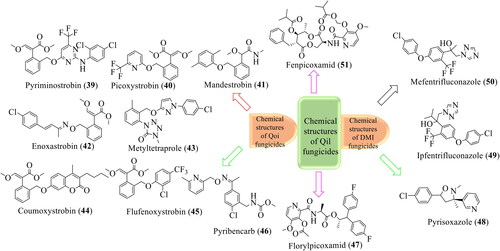
Figure 14. Structures of various succinate dehydrogenase inhibitors as pesticides (Ayer et al., Citation2019; Kiguchi et al., Citation2021; Umetsu & Shirai, Citation2020).
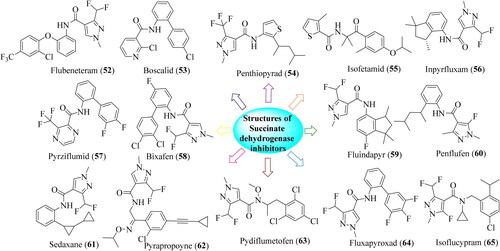
Double-stranded RNA (dsRNA), a novel RNA interference trigger, has the potential to be exploited to manage storage insects using insecticides (Silver et al., Citation2021). The strong species specificity of dsRNAs considerably increases their biosafety. In most cases, there are several bug species present. Secondly, the most effective target genes for each insect pest were identified, including Blattella germanica and Rhyzopertha dominica. A template was then produced by conjugating different regions from each of the chosen genes. This template was used to make a piece of chimeric dsRNA, allowing complementary regional specificity for genes from several insects to be employed. The data also revealed that non-target animals, such as Periplaneta americana and Zophobas atratus were not particularly vulnerable to chimeric dsRNA, which was the first report of a single dsRNA fragment effectively targeting numerous pest species. The technique holds promise for the future development of novel, precisely formulated biopesticides for the regulation of storage insects (Wang et al., Citation2021).
depicts the widespread usage of neonicotinoid insecticides (66–81) to protect crops from insect predators (Goulson, Citation2013). These pesticides primarily target nicotinic acetylcholine receptors (nAChRs). Using electrophysiological and molecular approaches, many nAChR subtypes with varying affinity for neonicotinoid insecticides have been discovered. However, the precise mode of action of neonicotinoids on insect nAChRs remains unknown. Radio-ligand binding studies with [3H]-bungarotoxin and [3H]-imidacloprid have contributed to a better understanding of the ligand-binding interactions between insect nAChRs and neonicotinoid pesticides (Bao et al., Citation2017). The use of imidacloprid as an insecticide is spreading around the world. It is poisonous to insects but not to vertebrates and functions as a nicotinic acetylcholine receptor agonist (nAChR). According to recent research that combines binding assays, electrophysiology, and molecular biology, interactions between nAChRs and imidacloprid are mediated by both alpha and non-alpha subunits (Jones & Sattelle, Citation2010).
Figure 15. Structures of various nicotine-based insecticides (Goulson, Citation2013).
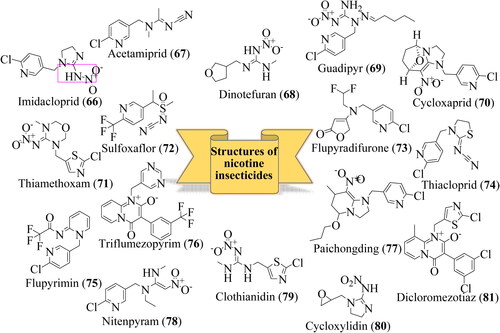
The diamides (82–88), as presented in (Teixeira & Andaloro, Citation2013), are the newest addition to the limited number of pesticide groups, with specific target action that is exceptionally effective, eliminates a wide range of pests, and has a favorable toxicity profile. Chlorantraniliprole (82), flubendiamide (83), and cyantraniliprole (84) are currently available diamide insecticides. Flubendiamide, the first diamide insecticide, was developed jointly by Nohyaku and Bayer (Teixeira & Andaloro, Citation2013). With the benefit they provide, growers are quickly adopting diamides, even though doing so may prohibit them from being employed in rotating resistance reduction techniques with alternate-chemistry insecticides (Teixeira & Andaloro, Citation2013). As a result of the insecticides’ targeting of ryanodine receptors and the resultant non-inhibited discharge of stored calcium, The insects exposed to diamide insecticides experience muscular paralysis, feeding stoppage, lethargy, and eventually death. Diamide insecticides have been viewed as the most viable option because they are less harmful to beneficial arthropods, mammals, and pollinators (Jactel et al., Citation2019; Teixeira & Andaloro, Citation2013; Zilnik et al., Citation2021). The ryanodine receptor is a novel target for anthranilic diamides, a recently discovered class of insecticides with exceptional control. When anthranilic diamides strongly activate this receptor, calcium reserves in the sarcoendoplasmic reticulum are released, affecting muscle contraction regulation (Cordova et al., Citation2006).
Figure 16. Structures of various diamide-based insecticides (Teixeira & Andaloro, Citation2013).
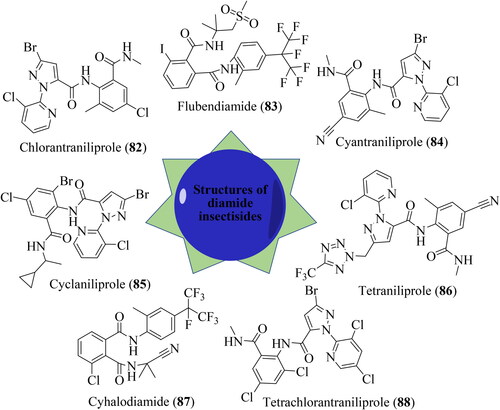
10. Conclusion and future perspectives
In conclusion, the categorization of pesticides and their lethal effects highlight the need for strict control and knowledgeable farming methods. It is important to comprehend the many pesticide categories and their possible carcinogenicity, as this overview explains, to reduce the health hazards connected to agricultural practices. Sustainable cohabitation between agricultural and public health is promoted by the development and use of safer alternatives, which are made possible by the careful balance between pest management and human health that calls for constant study and strict monitoring.
The research on pesticides has investigated literature of the last two decades years, which serves as a valuable and informative context for the future challenges and prospects. The impact of pesticides on human health is significant; therefore, further investigation is necessary to mitigate their toxicological consequences. It is imperative to acknowledge and tackle the neurotoxic, endocrine disruption, respiratory, and especially cancer hazards associated with the extensive utilization of organophosphates, atrazine, and phenoxy herbicides. Hence, it is imperative to employ computer-aided methodologies for further evaluations in epidemiological research to advance the advancement of this subject. Additionally, it is imperative to examine the mechanism by which these pesticides induce endocrine disruption and immunotoxicity. When analyzing the effects of pesticides, it is crucial to take into account the groups that have experienced significant harm in previous instances. It is essential to specifically involve farm owners or other cultivators, as they are more susceptible to the harmful effects of pesticides. Several studies have found a robust correlation between pesticide toxicity and cancer-causing changes. Nevertheless, subsequent inquiries have revealed a diminished link between the two. Pesticides have a well-established reputation for damaging DNA and other large molecules, inducing oxidative stress, and disrupting the endocrine system at the molecular level, as well as affecting gene expression.
Author contributions
Mohamed El Oirdi, Muhammad Asam Raza, and Mohd Farhan have designed the whole project. Muhammad Yaseen and Umme Farwa have drawn the structures and helped in data collection. Furqan Ali and Zeshan Ali Sandhu helped in drawn the figures. Mohamed El Oirdi and Mohd Farhan have written the first draft. Mohamed El Oirdi, Mohd Farhan, Hena Saeed Khan, and Insha Nahvi have finalized and helped in polishing the manuscript.
Disclosure statement
No potential conflict of interest was reported by the author(s).
Data availability statement
Data is available on request from corresponding author.
Additional information
Funding
Notes on contributors
Mohamed El Oirdi
Dr. Mohamed El Oirdi is an Assistant Professor of Molecular and Cellular Biology at King Faisal University, Saudi Arabia. His area of expertise is molecular plant-microbe interactions underlying plant immunity and the strategies employed by pathogens to evade these defenses. Recently, he has expanded his research to the investigation of DNA damage and chemoprevention mechanisms exploring the roles of plant polyphenols.
Muhammad Yaseen
Muhammad Yaseen has completed his Bachelor of science from Govt PG Jahanzeb College, Saidu Sharif Swat. Now, he is doing his Master of philosophy from Institute of Chemical Sciences, University of Swat, Charbagh, 19130, Swat, Pakistan. His research interest is synthesis of natural organic product and nanomaterial. He has well expertise in molecular docking and molecular dynamic simulation.
Umme Farwa
Umme Farwa received her Master’s of Philosophy degree from the Department of Chemistry, University of Gujrat, Pakistan in 2021. She is currently doing her PhD in Chemistry. Her present research interests are synthesis of heterocyclic organic compounds, nanomaterials, treatment of wastewater, bioenergy production, microbial community analysis, phytoxity studies, computational studies, and pharmaceutical applications.
Muhammad Asam Raza
Dr. Muhammad Asam Raza is a distinguished researcher and academician with a strong background in the field of chemistry. He earned his Ph.D. in Chemistry from GC University Lahore, Currently, Dr. Raza holds the esteemed position of Associate Professor at the University of Gujrat in Pakistan. His research journey has been marked by a profound focus on synthesis of new molecules and their application related to medicinal chemistry. Driven by a commitment to advancing scientific knowledge, he is working on synthesis of nanomaterials for industrial and environmental application. Dr. Raza’s contributions to the academic community are exemplified by his impressive publication record, which boasts more than 100 articles in reputable journals. Beyond his research endeavor, Dr. Raza has generously shared his expertise by serving as reviewers for numerous esteemed scientific journals.
Mohd Farhan
Dr. Mohd Farhan is an Associate Professor of Biochemistry at King Faisal University, Saudi Arabia. His research interest includes understanding the molecular mechanisms involved in the anticancer activity of plant-derived nutraceuticals.
Zeshan Ali Sandhu
Zeshan Ali Sandhu is a distinguished scientific researcher and scholar in the field of Chemistry holding an MPhil degree in Chemistry from the University of Gujrat. His academic journey has been marked by exceptional dedication and a passion for advancing the frontiers of scientific knowledge. Zeshan exhibited a keen aptitude for practical application of the theoretical concepts. He has expertise spans a variety of domains, including Photocatalysis, Electrocatalysis, Energy storage devices, and Environment remediation. Their interdisciplinary approach and holistic understanding of these areas showcase a unique ability to connect diverse scientific principles.
Furqan Ali
Mr. Furqan Ali, a dedicated and accomplished researcher in the field of extinguish studies, hailing from the esteemed University of Sialkot in Pakistan. With a formidable academic background, Mr. Ali holds a prestigious MPhil. degree, showcasing his commitment to scholarly excellence. Currently focusing his expertise on biomedical applications, Mr. Ali emerges as a leading figure in this dynamic domain.
Mohammad Aatif
Dr. Mohammad Aatif is an Assistant Professor of Public Health at King Faisal University, Saudi Arabia. His key research interests are in the areas of protein interaction biology and the anticancer activity of dietary compounds.
Hena Saeed Khan
Ms. Hena Saeed Khan is currently a lecturer in the Department of Basic Sciences at King Faisal University, Saudi Arabia. She obtained her master’s degree in botany from Pakistan. She has teaching experience of more than 5 years in the area of biological sciences. She has co-authored a number of publications.
Insha Nahvi
Ms. Insha Nahvi is currently a lecturer in the Department of Basic Sciences at King Faisal University, Saudi Arabia. She obtained her master’s degree in microbiology from India. She has teaching experience spanning more than 10 years in the area of biological sciences. She has co-authored a number of research articles, review papers, and book chapters.
References
- Abdou, K. (2019). Epidemiology of pesticides in developing countries.
- Abubakar, Y., Tijjani, H., Egbuna, C., Adetunji, C. O., Kala, S., Kryeziu, T. L., Ifemeje, J. C., & Patrick-Iwuanyanwu, K. C. (2020). Pesticides, history, and classification. In Natural remedies for pest, disease and weed control (pp. 1–24). Elsevier.
- Alavanja, M. C., & Bonner, M. R. (2012). Occupational pesticide exposures and cancer risk: A review. Journal of Toxicology and Environmental Health. Part B, Critical Reviews, 15(4), 238–263. https://doi.org/10.1080/10937404.2012.632358
- Ali, A., Hussain, F., Attacha, S., Kalsoom, A., Qureshi, W. A., Shakeel, M., Militky, J., Tomkova, B., & Kremenakova, D. (2021). Development of novel antimicrobial and antiviral green synthesized silver nanocomposites for the visual detection of Fe3+ ions. Nanomaterials, 11(8), 2076. https://doi.org/10.3390/nano11082076
- Amaral, A. F. (2014). Pesticides and asthma: challenges for epidemiology (p. 6). Frontiers Media SA.
- Andiappan, K., Sanmugam, A., Deivanayagam, E., Karuppasamy, K., Kim, H.-S., & Vikraman, D. (2018). In vitro cytotoxicity activity of novel Schiff base ligand–lanthanide complexes. Scientific Reports, 8(1), 3054. https://doi.org/10.1038/s41598-018-21366-1
- Asano, S., Yoshida, K., & Hirayama, Y. (2024). Sensitivity of tomato leaf mould–causing Fulvia fulva to seven succinate dehydrogenase inhibitor (SDHI) fungicides in Nara Prefecture, Japan and high efficacy of isofetamid in controlling SDHI‐resistant isolates. Journal of Phytopathology, 172(1), e13243. https://doi.org/10.1111/jph.13243
- Asiamah, J. Y., Tachie-Menson, J. W., Agyirifo, D. S., Agbeko, R., & Essem, F. (2020). Pesticides; A necessary evil in the agricultural value chain–A review. Sted Journal, 2(1), 53–63. https://doi.org/10.7251/STED2002053Y
- Ayer, K. M., Villani, S. M., Choi, M.-W., & Cox, K. D. (2019). Characterization of the VisdhC and VisdhD genes in Venturia inaequalis, and sensitivity to fluxapyroxad, pydiflumetofen, inpyrfluxam, and benzovindiflupyr. Plant Disease, 103(6), 1092–1100. https://doi.org/10.1094/PDIS-07-18-1225-RE
- Bachmann, S. (2018). Epidemiology of suicide and the psychiatric perspective. International Journal of Environmental Research and Public Health, 15(7), 1425. https://doi.org/10.3390/ijerph15071425
- Bao, H., Meng, X., & Liu, Z. (2017). Spider acetylcholine binding proteins: An alternative model to study the interaction between insect nAchRs and neonicotinoids. Insect Biochemistry and Molecular Biology, 90, 82–89. https://doi.org/10.1016/j.ibmb.2017.09.014
- Bergamaschi, A., Cavazza, F., & Bugiani, R. (2022). Optimization of copper applications using Laminarine for the sustainable control of grape downy mildew. BIO Web of Conferences, 50, 03005. https://doi.org/10.1051/bioconf/20225003005
- Bhatt, P., Zhou, X., Huang, Y., Zhang, W., & Chen, S. (2021). Characterization of the role of esterases in the biodegradation of organophosphate, carbamate, and pyrethroid pesticides. Journal of Hazardous Materials, 411, 125026. https://doi.org/10.1016/j.jhazmat.2020.125026
- Biondi, A., Desneux, N., Siscaro, G., & Zappalà, L. (2012). Using organic-certified rather than synthetic pesticides may not be safer for biological control agents: Selectivity and side effects of 14 pesticides on the predator Orius laevigatus. Chemosphere, 87(7), 803–812. https://doi.org/10.1016/j.chemosphere.2011.12.082
- Bish, M., Oseland, E., & Bradley, K. (2021). Off-target pesticide movement: A review of our current understanding of drift due to inversions and secondary movement. Weed Technology, 35(3), 345–356. https://doi.org/10.1017/wet.2020.138
- Blassioli-Moraes, M. C., Laumann, R. A., Michereff, M. F., & Borges, M. (2019). Semiochemicals for integrated pest management. In Sustainable agrochemistry: A compendium of technologies (pp. 85–112). Springer.
- Bonner, M. R., Freeman, L. E. B., Hoppin, J. A., Koutros, S., Sandler, D. P., Lynch, C. F., Hines, C. J., Thomas, K., Blair, A., & Alavanja, M. C. R. (2017). Occupational exposure to pesticides and the incidence of lung cancer in the agricultural health study. Environmental Health Perspectives, 125(4), 544–551. https://doi.org/10.1289/EHP456
- Buckley, N. A., Fahim, M., Raubenheimer, J., Gawarammana, I. B., Eddleston, M., Roberts, M. S., & Dawson, A. H. (2021). Case fatality of agricultural pesticides after self-poisoning in Sri Lanka: a prospective cohort study. The Lancet. Global Health, 9(6), e854–e862. https://doi.org/10.1016/S2214-109X(21)00086-3
- Cai, D. W. (2008). Understand the role of chemical pesticides and prevent misuses of pesticides. Bulletin of Agricultural Science and Technology 1(6), 36–38.
- Calaf, G. M. (2021). Role of organophosphorous pesticides and acetylcholine in breast carcinogenesis. In Seminars in cancer biology. Elsevier. https://doi.org/10.1016/j.semcancer.2021.03.016
- Calaf, G. M., Bleak, T. C., & Roy, D. (2021). Signs of carcinogenicity induced by parathion, malathion, and estrogen in human breast epithelial cells. Oncology Reports, 45(4), 1. https://doi.org/10.3892/or.2021.7975
- Caldas, E. D. (2016). Pesticide poisoning in Brazil. In Reference module in earth systems and environmental sciences. Elsevier.
- Campagnac, E., Fontaine, J., Lounès-Hadj Sahraoui, A., Laruelle, F., Durand, R., & Grandmougin-Ferjani, A. (2009). Fenpropimorph slows down the sterol pathway and the development of the arbuscular mycorrhizal fungus Glomus intraradices. Mycorrhiza, 19(6), 365–374. https://doi.org/10.1007/s00572-009-0238-1
- Cantrell, C. L., Dayan, F. E., & Duke, S. O. (2012). Natural products as sources for new pesticides. Journal of Natural Products, 75(6), 1231–1242. https://doi.org/10.1021/np300024u
- Cavoski, I., Caboni, P., & Miano, T. (2011). Natural pesticides and future perspectives. In Pesticides in the modern world-pesticides use and management (pp. 169–190). CBS Publishers & Distributors Pvt. Ltd.
- Cernuschi, M., Avidor, Y., & Rosenmund, A. (2023). Fungicidal mixtures. Google Patents.
- Chen, J., Lin, G., & Zhou, B.-S. (2004). Correlation between pesticides exposure and morbidity and mortality of breast cancer. Chinese Journal of Public Health, 20, 289–290.
- Chen, S., Daly, P., Zhou, D., Li, J., Wang, X., Deng, S., Feng, H., Wang, C., Sheikh, T. M. M., Chen, Y., Xue, T., Cai, F., Kubicek, C. P., Wei, L., & Druzhinina, I. S. (2022). The use of mutant and engineered microbial agents for biological control of plant diseases caused by Pythium: Achievements versus challenges. Fungal Biology Reviews, 40, 76–90. https://doi.org/10.1016/j.fbr.2022.03.001
- Chiasson, H., Vincent, C., & Bostanian, N. (2004). Insecticidal properties of a Chenopodium-based botanical. Journal of Economic Entomology, 97(4), 1378–1383. https://doi.org/10.1093/jee/97.4.1378
- Čokl, A. A., & Millar, J. G. (2009). Manipulation of insect signaling for monitoring and control of pest insects. Springer.
- Cordova, D., Benner, E. A., Sacher, M. D., Rauh, J. J., Sopa, J. S., Lahm, G. P., Selby, T. P., Stevenson, T. M., Flexner, L., Gutteridge, S., Rhoades, D. F., Wu, L., Smith, R. M., & Tao, Y. (2006). Anthranilic diamides: A new class of insecticides with a novel mode of action, ryanodine receptor activation. Pesticide Biochemistry and Physiology, 84(3), 196–214. https://doi.org/10.1016/j.pestbp.2005.07.005
- Dayan, F. E., Owens, D. K., Corniani, N., Silva, F. M. L., Watson, S. B., Howell, J., & Shaner, D. L. (2015). Biochemical markers and enzyme assays for herbicide mode of action and resistance studies. Weed Science, 63(SP1), 23–63. https://doi.org/10.1614/WS-D-13-00063.1
- Debnath, N., Das, S., Seth, D., Chandra, R., Bhattacharya, S. C., & Goswami, A. (2011). Entomotoxic effect of silica nanoparticles against Sitophilus oryzae (L.). Journal of Pest Science, 84(1), 99–105. https://doi.org/10.1007/s10340-010-0332-3
- del Pilar Navarrete-Meneses, M., & Pérez-Vera, P. (2019). Pyrethroid pesticide exposure and hematological cancer: epidemiological, biological and molecular evidence. Reviews on Environmental Health, 34(2), 197–210. https://doi.org/10.1515/reveh-2018-0070
- Diaz, J. H. (2016). Chemical and plant-based insect repellents: Efficacy, safety, and toxicity. Wilderness & Environmental Medicine, 27(1), 153–163. https://doi.org/10.1016/j.wem.2015.11.007
- Dixit, S., Srivastava, M., & Sharma, Y. (2018). Pesticide-and-human-health–A-rising-concern-of-the-21st-century (pp. 85–104). IGI Global.
- Eddleston, M., Eyer, P., Worek, F., Mohamed, F., Senarathna, L., von Meyer, L., Juszczak, E., Hittarage, A., Azhar, S., Dissanayake, W., Sheriff, M. H. R., Szinicz, L., Dawson, A. H., & Buckley, N. A. (2005). Differences between organophosphorus insecticides in human self-poisoning: a prospective cohort study. Lancet, 366(9495), 1452–1459. https://doi.org/10.1016/S0140-6736(05)67598-8
- El-Naggar, M. E., Abdelsalam, N. R., Fouda, M. M. G., Mackled, M. I., Al-Jaddadi, M. A. M., Ali, H. M., Siddiqui, M. H., & Kandil, E. E. (2020). Soil application of nano silica on maize yield and its insecticidal activity against some stored insects after the post-harvest. Nanomaterials, 10(4), 739. https://doi.org/10.3390/nano10040739
- Erba, P. A., Roberto, B. (2019). Hybrid imaging and radionuclide therapy in hemato-oncology. In Nuclear medicine textbook: Methodology and clinical applications (pp. 655–705).
- Fan, L. J. R. N. (2017). China founds pesticide office to combat pollution, overuse. 7, 2017. https://chinadialogue.net/en/pollution/10148-china-founds-pesticide-office-to-combat-pollution-overuse/.
- Fluegge, K. (2017). Overlooking relevant confounders in the assessment of pesticides and human health: a reply to Mostafalou and Abdollahi. Archives of Toxicology, 91(2), 601–602. https://doi.org/10.1007/s00204-016-1919-0
- Gerry, A., & Murillo, A. (2019). Promoting biosecurity through insect management at animal facilities. In Biosecurity in animal production and veterinary medicine: From principles to practice (pp. 243–281). CABI Wallingford UK.
- Ghimire, R., Utyasheva, L., Pokhrel, M., Rai, N., Chaudhary, B., Prasad, P. N., Bajracharya, S. R., Basnet, B., Das, K. D., Pathak, N. K., Baral, M. P., Pande, R., Paudel, P., Shrestha, S. K., Bajracharya, S., Chaudhary, R., Malla, G. B., Sharma, D. R., Basnyat, B., Maskey, M. K., & Eddleston, M. (2022). Intentional pesticide poisoning and pesticide suicides in Nepal. Clinical Toxicology, 60(1), 46–52. https://doi.org/10.1080/15563650.2021.1935993
- Golubev, A. (2022). Directions for improvement of the herbicide assortment in Russia at the beginning of the 21st century. Plant Protection News, 105(3), 104–113. https://doi.org/10.31993/2308-6459-2022-105-15392
- Goobie, G. C., Bernatsky, S., Ramsey-Goldman, R., & Clarke, A. E. (2015). Malignancies in systemic lupus erythematosus–A 2015 update. Current Opinion in Rheumatology, 27(5), 454–460. https://doi.org/10.1097/BOR.0000000000000202
- Goulson, D. (2013). An overview of the environmental risks posed by neonicotinoid insecticides. Journal of Applied Ecology, 50(4), 977–987. https://doi.org/10.1111/1365-2664.12111
- Gu, S. Y., Lee, H. S., Park, J.-S., Lee, S. J., Shin, H.-S., Kang, S. E., Chung, Y. M., Choi, H. N., Yoon, S. S., Jung, Y.-H., & Yoon, H. J. (2021). Determination and validation of an analytical method for dichlobentiazox in agricultural products with LC-MS/MS. Korean Journal of Environmental Agriculture, 40(2), 108–117. https://doi.org/10.5338/KJEA.2021.40.2.13
- Hagiwara, H., Ezaki, R., Hamada, T., Tsuda, M., & Ebihara, K. (2019). Development of a novel fungicide, tolprocarb. Journal of Pesticide Science, 44(3), 208–213. https://doi.org/10.1584/jpestics.J19-01
- Hassaan, M. A., & El Nemr, A. (2020). Pesticides pollution: Classifications, human health impact, extraction and treatment techniques. The Egyptian Journal of Aquatic Research, 46(3), 207–220. https://doi.org/10.1016/j.ejar.2020.08.007
- Hassan, A. S. (2019). Inorganic-based pesticides: A review article. Egyptian Scientific Journal of Pesticides, 5, 39–52.
- Hatamoto, M., Aizawa, R., Koda, K., & Fukuchi, T. (2021). Aminopyrifen, a novel 2-aminonicotinate fungicide with a unique effect and broad-spectrum activity against plant pathogenic fungi. Journal of Pesticide Science, 46(2), 198–205. https://doi.org/10.1584/jpestics.D20-094
- Heo, Y.-J., Kwak, S.-Y., Sarker, A., Lee, S.-H., Choi, J.-W., Oh, J.-E., Abdulkareem, L., & Kim, J.-E. (2023). Uptake and translocation of fungicide picarbutrazox in greenhouse cabbage: the significance of translocation factors and home processing. Environmental Science and Pollution Research International, 30(14), 40919–40930. https://doi.org/10.1007/s11356-022-25087-x
- Hillebrand, S., Tietjen, K., & Zundel, J. L. (2019). Fungicides with unknown mode of action. Modern Crop Protection Compounds, 2, 911–932.
- Hoppin, J. A., Umbach, D. M., London, S. J., Henneberger, P. K., Kullman, G. J., Alavanja, M. C. R., & Sandler, D. P. (2008). Pesticides and atopic and nonatopic asthma among farm women in the agricultural health study. American Journal of Respiratory and Critical Care Medicine, 177(1), 11–18. https://doi.org/10.1164/rccm.200706-821OC
- Hossain, L., Rahman, R., & Khan, M. S. (2017). Alternatives of pesticides. In Pesticide residue in foods (pp. 147–165). Springer.
- Hou, R., Zhang, Z., Pang, S., Yang, T., Clark, J. M., & He, L. (2016). Alteration of the nonsystemic behavior of the pesticide ferbam on tea leaves by engineered gold nanoparticles. Environmental Science & Technology, 50(12), 6216–6223. https://doi.org/10.1021/acs.est.6b01336
- Hyder, M. S., Dutta, S. D., Ganguly, K., & Lim, K. T. (2021). Chapter 4 – Are CRISPR/Cas9 and RNA interference-based new technologies to relocate crop pesticides? In K. A. Abd-Elsalam & K.-T. Lim (Eds.), CRISPR and RNAi systems (pp. 47–63). Elsevier.
- Ibáñez, M. D., Sanchez-Ballester, N. M., & Blázquez, M. A. (2020). Encapsulated Limonene: A pleasant lemon-like aroma with promising application in the agri-food industry. A review. Molecules, 25(11), 2598. https://doi.org/10.3390/molecules25112598
- Ibrahim, M. A., Kainulainen, P., & Aflatuni, A. (2001). Insecticidal, repellent, antimicrobial activity and phytotoxicity of essential oils: With special reference to limonene and its suitability for control of insect pests. Agricultural and Food Science, 10(3), 243–259. https://doi.org/10.23986/afsci.5697
- Ignatieva, M., Haase, D., Dushkova, D., & Haase, A. (2020). Lawns in cities: From a globalised urban green space phenomenon to sustainable nature-based solutions. Land, 9(3), 73. https://doi.org/10.3390/land9030073
- Iqbal, T., Ahmed, N., Shahjeer, K., Ahmed, S., Al-Mutairi, K. A., Khater, H. F., & Ali, R. F. (2021). Botanical insecticides and their potential as anti-insect/pests: Are they successful against insects and pests? In Global decline of insects. IntechOpen.
- Islam, M. S., & Morshed, A. (2013). Study on homemade bio-pesticides and organic pest management in organic farming. The International Journal of Engineering and Science, 2(7), 18–25.
- Islam, M., & Morshed, A. (2013). Study on homemade bio-pesticides and organic pest management in organic farming.
- Isman, M. B., & Miresmailli, S. (2011). Plant essential oils as repellents and deterrents to agricultural pests. In Recent developments in invertebrate repellents (pp. 67–77). American Chemical Society.
- Ito, H., Takada, T., Morimoto, M., Komai, H., Kajino, F., Ohara, T., Tamagawa, Y., Tsuda, M., & Banba, S. (2023). Design and biological activity of a novel fungicide, quinofumelin. Journal of Pesticide Science, 48(1), 22–27. https://doi.org/10.1584/jpestics.D22-042
- Jactel, H., Verheggen, F., Thiéry, D., Escobar-Gutiérrez, A. J., Gachet, E., & Desneux, N. (2019). Alternatives to neonicotinoids. Environment International, 129, 423–429. https://doi.org/10.1016/j.envint.2019.04.045
- Jayakody, N., Harris, E. C., & Coggon, D. (2015). Phenoxy herbicides, soft-tissue sarcoma and non-Hodgkin lymphoma: A systematic review of evidence from cohort and case–control studies. British Medical Bulletin, 114(1), 75–94. https://doi.org/10.1093/bmb/ldv008
- Jeschke, P. (2021). Status and outlook for acaricide and insecticide discovery. Pest Management Science, 77(1), 64–76. https://doi.org/10.1002/ps.6084
- Jones, A. K., & Sattelle, D. B. (2010). Diversity of insect nicotinic acetylcholine receptor subunits. Advances in Experimental Medicine and Biology, 683, 25–43.
- Kabtni, S., Sdouga, D., Bettaib Rebey, I., Save, M., Trifi-Farah, N., Fauconnier, M.-L., & Marghali, S. (2020). Influence of climate variation on phenolic composition and antioxidant capacity of Medicago minima populations. Scientific Reports, 10(1), 8293. https://doi.org/10.1038/s41598-020-65160-4
- Kamaruzaman, N. A., Leong, Y.-H., Jaafar, M. H., Mohamed Khan, H. R., Abdul Rani, N. A., Razali, M. F., & Abdul Majid, M. I. (2020). Epidemiology and risk factors of pesticide poisoning in Malaysia: A retrospective analysis by the National Poison Centre (NPC) from 2006 to 2015. BMJ Open, 10(6), e036048. https://doi.org/10.1136/bmjopen-2019-036048
- Karunarathne, A., Gunnell, D., Konradsen, F., & Eddleston, M. (2020). How many premature deaths from pesticide suicide have occurred since the agricultural Green Revolution? Clinical Toxicology, 58(4), 227–232. https://doi.org/10.1080/15563650.2019.1662433
- Khursheed, A., Rather, M. A., Jain, V., Wani, A. R., Rasool, S., Nazir, R., Malik, N. A., & Majid, S. A. (2022). Plant based natural products as potential ecofriendly and safer biopesticides: A comprehensive overview of their advantages over conventional pesticides, limitations and regulatory aspects. Microbial Pathogenesis, 173(Pt A), 105854. https://doi.org/10.1016/j.micpath.2022.105854
- Kimura, N., Hashizume, M., Kusaba, T., & Tanaka, S. (2017). Development of the novel fungicide fenpyrazamine. Journal of Pesticide Science, 42(3), 137–143. https://doi.org/10.1584/jpestics.J17-01
- Kramer, W., Buchel, K. J. J. W., & Sons, N. Y. (1983). Chemistry of pesticides (pp. 280–281). The New York Academy of Sciences.
- Kumar, J. I. N., Bora, A., Kumar, R. N., Amb, M. K., & Khan, S. (2013). Toxicity analysis of pesticides on cyanobacterial species by 16S rDNA molecular characterization. Proceedings of the International Academy of Ecology and Environmental Sciences, 3(2), 101.
- Kumar, J., Ramlal, A., Mallick, D., & Mishra, V. (2021). An overview of some biopesticides and their importance in plant protection for commercial acceptance. Plants, 10(6), 1185. https://doi.org/10.3390/plants10061185
- L’Héritier, F., Marques, M., Fauteux, M., Fauteux, M., & Gaudreau, L. (2014). Defining molecular sensors to assess long-term effects of pesticides on carcinogenesis. International Journal of Molecular Sciences, 15(9), 17148–17161.
- Lee, J. H., & Kim, Y. C. (2022). Strobilurin fungicides activate plant defense against viral and bacterial infections and improve plant vigor. Journal of Plant Diseases and Protection, 129(5), 1031–1040. https://doi.org/10.1007/s41348-022-00629-0
- Lee, S.-K., Rhee, J. S., Jung, J. M., & Lee, H. S. (2010). Pesticide poisoning deaths detected at the National Forensic Service Headquarters in Seoul of Korea: A five-year survey (2005–2009). Environmental Analysis Health and Toxicology, 25(4), 263–271.
- Lee, Y. Y., Chisholm, D., Eddleston, M., Gunnell, D., Fleischmann, A., Konradsen, F., Bertram, M. Y., Mihalopoulos, C., Brown, R., Santomauro, D. F., Schess, J., & van Ommeren, M. (2021). The cost-effectiveness of banning highly hazardous pesticides to prevent suicides due to pesticide self-ingestion across 14 countries: an economic modelling study. The Lancet. Global Health, 9(3), e291–e300. https://doi.org/10.1016/S2214-109X(20)30493-9
- Liu, C., Men W., Liu Y., & Zhang H. (2002). The pollution of pesticides in soils and its bioremediation. System Sciences and Comprehensive Studies in Agriculture, 18(4), 295–297.
- Liu, Y., Lan, Z., Yin, Y., Liu, N. H., & Tong, Y. (2021). Trends in suicide rates and the case-fatality of pesticide self-poisoning in an agricultural county in China, 2009 to 2014. Journal of Affective Disorders, 283, 52–59. https://doi.org/10.1016/j.jad.2021.01.024
- Lushchak, V. I., Matviishyn, T. M., Husak, V. V., Storey, J. M., & Storey, K. B. (2018). Pesticide toxicity: A mechanistic approach. EXCLI Journal, 17, 1101.
- Ma, W., & Zheng, H. (2022). Heterogeneous impacts of information technology adoption on pesticide and fertiliser expenditures: Evidence from wheat farmers in China. Australian Journal of Agricultural and Resource Economics, 66(1), 72–92. https://doi.org/10.1111/1467-8489.12446
- Mahmood, I., Imadi, S. R., Shazadi, K., Gul, A., Hakeem, K. R. (2016). Effects of pesticides on environment. In Plant, soil and microbes (pp. 253–269). Springer.
- Malyan, S. K., Singh, R., Rawat, M., Kumar, M., Pugazhendhi, A., Kumar, A., Kumar, V., & Kumar, S. S. (2019). An overview of carcinogenic pollutants in groundwater of India. Biocatalysis and Agricultural Biotechnology, 21, 101288. https://doi.org/10.1016/j.bcab.2019.101288
- Manna, M. C., Rahman, M. M., Naidu, R., Bari, A. F., Singh, A., Thakur, J., Ghosh, A., Patra, A. K., Chaudhari, S., & Subbarao, A. (2021). Organic farming: A prospect for food, environment and livelihood security in Indian agriculture. Advances in Agronomy, 170, 101–153.
- Mehrpour, O., Jafarzadeh, M., & Abdollahi, M. (2012). A systematic review of aluminium phosphide poisoning. Arhiv za Higijenu Rada i Toksikologiju, 63(1), 61–73. https://doi.org/10.2478/10004-1254-63-2012-2182
- Mew, E. J., Padmanathan, P., Konradsen, F., Eddleston, M., Chang, S.-S., Phillips, M. R., & Gunnell, D. (2017). The global burden of fatal self-poisoning with pesticides 2006–2015: Systematic review. Journal of Affective Disorders, 219, 93–104. https://doi.org/10.1016/j.jad.2017.05.002
- Mfarrej, M. F. B., & Rara, F. M. (2019). Competitive, sustainable natural pesticides. Acta Ecologica Sinica, 39(2), 145–151. https://doi.org/10.1016/j.chnaes.2018.08.005
- Mie, A., Andersen, H. R., Gunnarsson, S., Kahl, J., Kesse-Guyot, E., Rembiałkowska, E., Quaglio, G., & Grandjean, P. (2017). Human health implications of organic food and organic agriculture: A comprehensive review. Environmental Health, 16(1), 1–22. https://doi.org/10.1186/s12940-017-0315-4
- Miligi, L., Costantini, A. S., Veraldi, A., Benvenuti, A., & Vineis, P. (2006). Cancer and pesticides: An overview and some results of the Italian multicenter case–control study on hematolymphopoietic malignancies. Annals of the New York Academy of Sciences, 1076(1), 366–377. https://doi.org/10.1196/annals.1371.036
- Moorthy, P. (2018). Strengthening integrated pest management (IPM) for sustainable organic horticulture production. Sustainable Horticulture Development and Nutrition Security, 3, 250.
- Mostafalou, S., & Abdollahi, M. (2017). Pesticides: An update of human exposure and toxicity. Archives of Toxicology, 91(2), 549–599. https://doi.org/10.1007/s00204-016-1849-x
- Mursiti, S., Lestari, N. A., Febriana, Z., Rosanti, Y. M., & Ningsih, T. W. (2019). The activity of D-limonene from sweet orange peel (Citrus sinensis L.) extract as a natural insecticide controller of bedbugs (Cimex cimicidae). Oriental Journal of Chemistry, 35(4), 1420–1425. https://doi.org/10.13005/ojc/350424
- Naeem, M., Jimenez Bremont, J. F., Ansari, A. A., Gill, S. S. (2022). Agrochemicals in soil and environment: impacts and remediation. Springer Nature.
- Nair, P. A., & Sujatha, C. (2012). Organic pollutants as endocrine disruptors: organometallics, PAHs, organochlorine, organophosphate and carbamate insecticides, phthalates, dioxins, phytoestrogens, alkyl phenols and bisphenol A. In Environmental chemistry for a sustainable world: Volume 1: Nanotechnology and health risk (pp. 259–309). Springer.
- Nicolopoulou-Stamati, P., Maipas, S., Kotampasi, C., Stamatis, P., & Hens, L. (2016). Chemical pesticides and human health: The urgent need for a new concept in agriculture. Frontiers in Public Health, 4, 148–148. https://doi.org/10.3389/fpubh.2016.00148
- Niemeyer, J. C., Chelinho, S., & Sousa, J. P. (2017). Soil ecotoxicology in Latin America: Current research and perspectives. Environmental Toxicology and Chemistry, 36(7), 1795–1810. https://doi.org/10.1002/etc.3792
- Nuruzzaman, M., Rahman, M. M., Liu, Y., & Naidu, R. (2016). Nanoencapsulation, nano-guard for pesticides: A new window for safe application. Journal of Agricultural and Food Chemistry, 64(7), 1447–1483. https://doi.org/10.1021/acs.jafc.5b05214
- Oberemok, V. V., & Skorokhod, O. A. (2014). Single-stranded DNA fragments of insect-specific nuclear polyhedrosis virus act as selective DNA insecticides for gypsy moth control. Pesticide Biochemistry and Physiology, 113, 1–7. https://doi.org/10.1016/j.pestbp.2014.05.005
- Oberemok, V. V., Laikova, K. V., Gninenko, Y. I., Zaitsev, A. S., Nyadar, P. M., & Adeyemi, T. A. (2015). A short history of insecticides. Journal of Plant Protection Research, 55(3), 221–226. https://doi.org/10.1515/jppr-2015-0033
- Oberemok, V. V., Laikova, K. V., Zaitsev, A. S., Nyadar, P. M., Shumskykh, M. N., & Gninenko, Y. I. (2015). DNA insecticides based on IAP3 gene fragments of cabbage looper and gypsy moth nuclear polyhedrosis viruses show selectivity for non-target insects. Archives of Biological Sciences, 67(3), 785–792. https://doi.org/10.2298/ABS141230037O
- Oberemok, V., & Nyadar, P. (2016). DNA insecticides.
- Ogawa, M., Nishimura, A., Abe, Y., Fukumori, Y., Suzuki, K., & Mitani, S. (2023). Fungicidal spectrum and biological properties of a new fungicide, pyriofenone. Journal of Pesticide Science, 48(2), 65–70. https://doi.org/10.1584/jpestics.D22-068
- Pandya, I. Y. (2018). Pesticides and their applications in agriculture. Asian Journal of Applied Science and Technology, 2(2), 894–900.
- Parker, K. M., & Sander, M. (2017). Environmental fate of insecticidal plant-incorporated protectants from genetically modified crops: Knowledge gaps and research opportunities. Environmental Science & Technology, 51(21), 12049–12057. https://doi.org/10.1021/acs.est.7b03456
- Parmar, P., Rathod, G. B., Rathod, S., Parikh, A. (2015). Demographic profile of aluminium phosphide poisoning in Gandhinagar, Gujarat. International Archives of Integrated Medicine, 2(1), 76–82.
- Parween, T., & Jan, S. (2019). Chapter 1 – Pesticides and environmental ecology. In T. Parween & S. Jan (Eds.), Ecophysiology of pesticides (pp. 1–38). Academic Press.
- Parween, T., & Jan, S. (2019). Ecophysiology of pesticides: Interface between pesticide chemistry and plant physiology. Academic Press.
- Pathania, D., Thakur, M., & Sharma, A. (2020). Photocatalytical degradation of pesticides. In Nano-materials as photocatalysts for degradation of environmental pollutants (pp. 153–172). Elsevier.
- Pedroso, T. M. A., Benvindo-Souza, M., de Araújo Nascimento, F., Woch, J., dos Reis, F. G., & de Melo e Silva, D. (2022). Cancer and occupational exposure to pesticides: A bibliometric study of the past 10 years. Environmental Science and Pollution Research, 29(12), 17464–17475. https://doi.org/10.1007/s11356-021-17031-2
- Pelaez, V., da Silva, L. R., & Araujo, E. B. (2013). Regulation of pesticides: A comparative analysis. Science and Public Policy, 40(5), 644–656. https://doi.org/10.1093/scipol/sct020
- Peshin, R., & Zhang, W. (2014). Integrated pest management and pesticide use. In D. Pimentel & R. Peshin (Eds.), Integrated pest management: Pesticide problems (Vol. 3, pp. 1–46). Springer Netherlands.
- Peshin, R., Bandral, R. S., Zhang, W. J., Wilson, L., Dhawan, A. K. (2009). Integrated pest management: a global overview of history, programs and adoption (pp. 1–49). Springer.
- Pettis, G. V., Braman, S. K., Guillebeau, L. P., & Sparks, B. (2005). Evaluation of insecticides for suppression of Japanese beetle, Popillia japonica Newman, and crapemyrtle aphid, Tinocallis kahawaluokalani Kirkaldy. Journal of Environmental Horticulture, 23(3), 145–148. https://doi.org/10.24266/0738-2898-23.3.145
- Pielke, R.Jr., & Linnér, B.-O. (2019). From green revolution to green evolution: A critique of the political myth of averted famine. Minerva, 57(3), 265–291. https://doi.org/10.1007/s11024-019-09372-7
- Pimentel, D. (2009). Pesticides and pest control. In Integrated pest management: innovation-development process (pp. 83–87). Springer.
- Pimentel, D., & Greiner, A. (1997). Environmental and socio-economics impacts of pesticida use (pp. 51–78). John Wiley & Sons.
- Rajamani, M., & Negi, A. (2021). Biopesticides for pest management. In Sustainable bioeconomy: Pathways to sustainable development goals (pp. 239–266). Springer.
- Rani, L., Thapa, K., Kanojia, N., Sharma, N., Singh, S., Grewal, A. S., Srivastav, A. L., & Kaushal, J. (2021). An extensive review on the consequences of chemical pesticides on human health and environment. Journal of Cleaner Production, 283, 124657. https://doi.org/10.1016/j.jclepro.2020.124657
- Rao, J. C. S., Neelima, P., & Rao, K. G. (2017). A review on the toxicity and other effects of Dichlorvos, an organophosphate pesticide to the freshwater fish. Bioscience Discovery, 8(3), 402–415.
- Rashid, B., Husnain, T., & Riazuddin, S. (2010). Herbicides and pesticides as potential pollutants: a global problem. Plant Adaptation and Phytoremediation, 427–447.
- Rather, M. I., Khan, T. A., & Farooqi, I. (2022). Assessment of environmental impacts of pesticides: Evidence from meta-analysis. In Towards sustainable natural resources: Monitoring and managing ecosystem biodiversity (pp. 235–252). Springer.
- Rathore, H. S., Mittal, S., & Nollet, L. (2015). Biochemical pesticides (p. 155). Taylor and Francis.
- Rawat, N. S., Lathwal, S. S., Panchbhai, G. J., Pal, R. K., Jha, A. K., Jamra, M. S. (2020). Physical, microbial and biochemical composition of bio-pesticides based on cow urine and dung with medicinal plants. Journal of Pharmacognosy and Phytochemistry, 9(5S), 754–758.
- Reichenberger, S., Bach, M., Skitschak, A., & Frede, H.-G. (2007). Mitigation strategies to reduce pesticide inputs into ground-and surface water and their effectiveness; A review. The Science of the Total Environment, 384(1–3), 1–35. https://doi.org/10.1016/j.scitotenv.2007.04.046
- Relyea, R. A. (2012). New effects of Roundup on amphibians: Predators reduce herbicide mortality; herbicides induce antipredator morphology. Ecological Applications, 22(2), 634–647. https://doi.org/10.1890/11-0189.1
- Salas, S. E., Shepherd, C. P., Ngugi, H. K., & Genet, J.-L. (2019). Disease control attributes of oxathiapiprolin fungicides for management of cucurbit downy mildew. Plant Disease, 103(11), 2812–2820. https://doi.org/10.1094/PDIS-02-19-0396-RE
- Saleem, H., & Zaidi, S. J. (2020). Recent developments in the application of nanomaterials in agroecosystems. Nanomaterials, 10(12), 2411. https://doi.org/10.3390/nano10122411
- Sanahuja, G., Banakar, R., Twyman, R. M., Capell, T., & Christou, P. (2011). Bacillus thuringiensis: A century of research, development and commercial applications. Plant Biotechnology Journal, 9(3), 283–300. https://doi.org/10.1111/j.1467-7652.2011.00595.x
- Saranya, S., Selvi, A., Babujanarthanam, R., Rajasekar, A., & Madhavan, J. (2020). Insecticidal activity of nanoparticles and mechanism of action. In Model organisms to study biological activities and toxicity of nanoparticles (pp. 243–266). Springer.
- Sarker, S., Akbor, M. A., Nahar, A., Hasan, M., Islam, A. R. M. T., & Siddique, M. A. B. (2021). Level of pesticides contamination in the major river systems: A review on South Asian countries perspective. Heliyon, 7(6), e07270. https://doi.org/10.1016/j.heliyon.2021.e07270
- Sarmah, A. K., Müller, K., & Ahmad, R. (2004). Fate and behaviour of pesticides in the agroecosystem—A review with a New Zealand perspective. Soil Research, 42(2), 125–154. https://doi.org/10.1071/SR03100
- Sarwar, M. (2016). Inorganic insecticides used in landscape settings and insect pests. Chemistry Research Journal, 1(1), 50–57.
- Sautua, F. J., & Carmona, M. A. (2022). Baseline sensitivity of QoI-resistant isolates of Pyrenophora tritici-repentis from Argentina to fenpicoxamid. European Journal of Plant Pathology, 164(4), 583–591. https://doi.org/10.1007/s10658-022-02582-y
- Saw, G., Nagdev, P., Jeer, M., & Murali-Baskaran, R. K. (2023). Silica nanoparticles mediated insect pest management. Pesticide Biochemistry and Physiology, 194, 105524. https://doi.org/10.1016/j.pestbp.2023.105524
- Saxena, S. (2021). An analysis of effects of pesticides on environment.
- Semu, E., Tindwa, H., & Singh, B. (2019). Heavy metals and organopesticides: Ecotoxicology, health effects and mitigation options with emphasis on Sub-Saharan Africa. Toxicology: Current Research, 3(1), 1–14. https://doi.org/10.24966/TCR-3735/100010
- Shaffer, L. (2020). Inner workings: RNA-based pesticides aim to get around resistance problems. Proceedings of the National Academy of Sciences of the United States of America, 117(52), 32823–32826. https://doi.org/10.1073/pnas.2024033117
- Shah, M. A., Wani, S. H., & Khan, A. A. (2016). Nanotechnology and insecticidal formulations. Journal of Food Bioengineering and Nanoprocessing, 1(3), 285–310.
- Sharma, A., Kumar, V., Shahzad, B., Tanveer, M., Sidhu, G. P. S., Handa, N., Kohli, S. K., Yadav, P., Bali, A. S., Parihar, R. D., Dar, O. I., Singh, K., Jasrotia, S., Bakshi, P., Ramakrishnan, M., Kumar, S., Bhardwaj, R., & Thukral, A. K. (2019). Worldwide pesticide usage and its impacts on ecosystem. SN Applied Sciences, 1(11), 1446. https://doi.org/10.1007/s42452-019-1485-1
- Sheridan, K. (2017). Bee-harming pesticides in 75 percent of honey worldwide: Study. phys.org
- Sherwani, S. I., Arif, I. A., & Khan, H. A. (2015). Modes of action of different classes of herbicides. In Herbicides, physiology of action, and safety (pp. 165–186). Intech Open.
- Shorey, H. H. (1973). Behavioral responses to insect pheromones. Annual Review of Entomology, 18(1), 349–380. https://doi.org/10.1146/annurev.en.18.010173.002025
- Silver, K., Cooper, A. M., & Zhu, K. Y. (2021). Strategies for enhancing the efficiency of RNA interference in insects. Pest Management Science, 77(6), 2645–2658. https://doi.org/10.1002/ps.6277
- So, K., Takuya, I., Yuichi, M., Fukumatsu, I., & Hiroshi, S. (2021). Discovery and biological profile of inpyrfluxam: A new broad-spectrum succinate dehydrogenase inhibitor fungicide. In Recent highlights in the discovery and optimization of crop protection products (pp. 381–389). Elsevier.
- Sodnikar, K., Parker, K. M., Stump, S. R., ThomasArrigo, L. K., & Sander, M. (2021). Adsorption of double-stranded ribonucleic acids (dsRNA) to iron (oxyhydr-) oxide surfaces: comparative analysis of model dsRNA molecules and deoxyribonucleic acids (DNA). Environmental Science: Processes & Impacts, 23(4), 605–620.
- Sparks, T. C., & Bryant, R. J. (2022). Innovation in insecticide discovery: Approaches to the discovery of new classes of insecticides. Pest Management Science, 78(8), 3226–3247. https://doi.org/10.1002/ps.6942
- Stehle, S., & Schulz, R. (2015). Pesticide authorization in the EU—Environment unprotected? Environmental Science and Pollution Research International, 22(24), 19632–19647. https://doi.org/10.1007/s11356-015-5148-5
- Stenzel, K., & Vors, J. P. (2019). Sterol biosynthesis inhibitors. Modern Crop Protection Compounds, 2, 797–844.
- Syberg, K., & Hansen, S. F. (2016). Environmental risk assessment of chemicals and nanomaterials—The best foundation for regulatory decision-making? The Science of the Total Environment, 541, 784–794. https://doi.org/10.1016/j.scitotenv.2015.09.112
- Teixeira, L. A., & Andaloro, J. T. (2013). Diamide insecticides: Global efforts to address insect resistance stewardship challenges. Pesticide Biochemistry and Physiology, 106(3), 76–78. https://doi.org/10.1016/j.pestbp.2013.01.010
- Tsao, R., Peterson, C. J., & Coats, J. R. (2002). Glucosinolate breakdown products as insect fumigants and their effect on carbon dioxide emission of insects. BMC Ecology, 2(1), 5. https://doi.org/10.1186/1472-6785-2-5
- Umetsu, N., & Shirai, Y. (2020). Development of novel pesticides in the 21st century. Journal of Pesticide Science, 45(2), 54–74. https://doi.org/10.1584/jpestics.D20-201
- Valavanidis, A. (2018). Neonicotinoid insecticides. Banned by the European Union in 2018 after scientific studies concluded their use harm honey bees (Vol. 1). Scientific Reviews.
- Verma, N., & Bhardwaj, A. (2015). Biosensor technology for pesticides—A review. Applied Biochemistry and Biotechnology, 175(6), 3093–3119. https://doi.org/10.1007/s12010-015-1489-2
- Vimala Devi, P. S., Duraimurugan, P., & Chandrika, K. S. V. P. (2019). Chapter 10 – Bacillus thuringiensis-based nanopesticides for crop protection. In O. Koul (Ed.). Nano-biopesticides today and future perspectives (pp. 249–260). Academic Press.
- Wang, K., Cheng, H., Chen, J., Zhu, G., Tang, P., & Han, Z. (2021). Chimeric double-stranded RNAs could act as tailor-made pesticides for controlling storage insects. Journal of Agricultural and Food Chemistry, 69(22), 6166–6171. https://doi.org/10.1021/acs.jafc.1c00853
- Wang, Y., Zhang, H., Li, H., & Miao, X. (2011). Second-generation sequencing supply an effective way to screen RNAi targets in large scale for potential application in pest insect control. PLOS One, 6(4), e18644. https://doi.org/10.1371/journal.pone.0018644
- Wang, Z., Lv, X., Wang, R., He, Z., Feng, W., Liu, W., Yang, C., Wang, Z., Ke, Q., Tao, K., & Chen, Q. (2023). Use of oxathiapiprolin for controlling soybean root rot caused by Phytophthora sojae: Efficacy and mechanism of action. Pest Management Science, 79(1), 381–390. https://doi.org/10.1002/ps.7207
- Wesseling, C., Corriols, M., & Bravo, V. (2005). Acute pesticide poisoning and pesticide registration in Central America. Toxicology and Applied Pharmacology, 207(2 Suppl), 697–705. https://doi.org/10.1016/j.taap.2005.03.033
- Witzgall, P., Kirsch, P., & Cork, A. (2010). Sex pheromones and their impact on pest management. Journal of Chemical Ecology, 36(1), 80–100. https://doi.org/10.1007/s10886-009-9737-y
- Wojciechowska, M., Stepnowski, P., & Gołębiowski, M. (2016). The use of insecticides to control insect pests. Invertebrate Survival Journal, 13(1), 210–220.
- Yadav, I. C., & Devi, N. L. (2017). Pesticides classification and its impact on human and environment. Environmental Science and Engineering, 6, 140–158.
- Yalçın, M. (2023). Pheromone-based techniques in sustainable pest management.
- Yao, C., & Mathieson, J. T. (2023). Synergistic mixtures for fungal control in cereals. Google Patents.
- Zhang, W. (2018a). Global pesticide use: Profile, trend, cost/benefit and more. International Academy of Ecology and Environmental Sciences, 8(1), 1.
- Zhang, W. J. N. (2018b). A long-term trend of cancer-induced deaths in European countries. Network Pharmacology, 3(1–2), 1–9.
- Zhang, W., Bai, C., & Liu, G. (2007). A longer-term forecast on global supply and demand of food products (Vol. 5). Journal of Food, Agriculture & Environment.
- Zhang, W. J., Jiang, F. B., Ou, J. F. (2011). Global pesticide consumption and pollution: With China as a focus. Proceedings of the International Academy of Ecology and Environmental Sciences, 1(2), 125.
- Zhang, W., Jiang, F., & Ou, J. (2011). Global pesticide consumption and pollution: With China as a focus. Proceedings of the International Academy of Ecology and Environmental Sciences, 1(2), 125.
- Zilnik, G., Kraus, D. A., & Burrack, H. J. (2021). Translocation and persistence of soil applied chlorantraniliprole as a control measure for Chloridea virescens in tobacco plant Nicotiana tabacum. Crop Protection, 140, 105413. https://doi.org/10.1016/j.cropro.2020.105413
- Zotti, M., Dos Santos, E. A., Cagliari, D., Christiaens, O., Taning, C. N. T., & Smagghe, G. (2018). RNA interference technology in crop protection against arthropod pests, pathogens and nematodes. Pest Management Science, 74(6), 1239–1250. https://doi.org/10.1002/ps.4813


